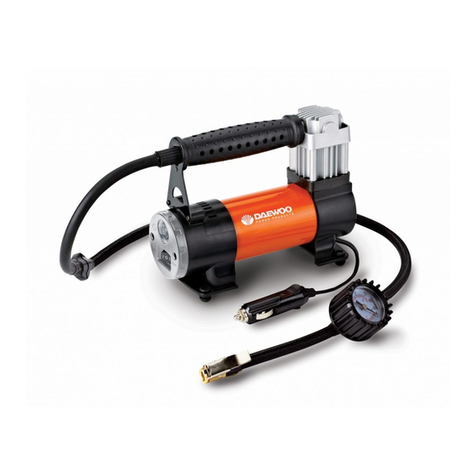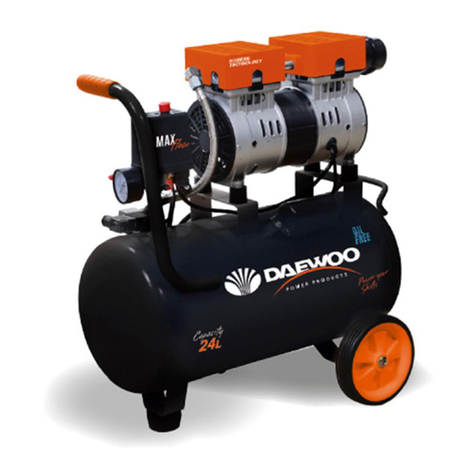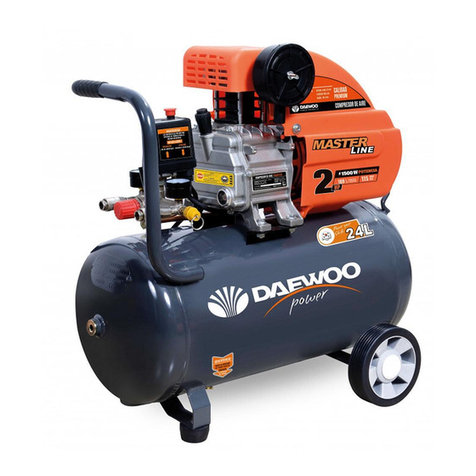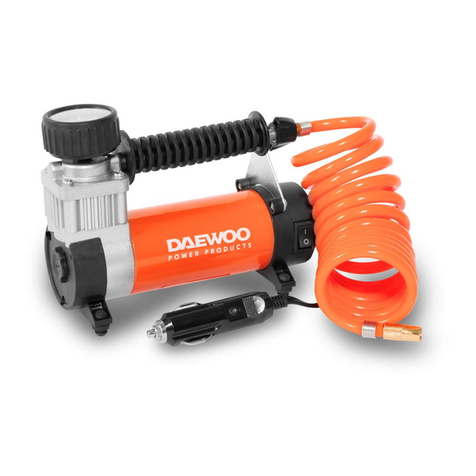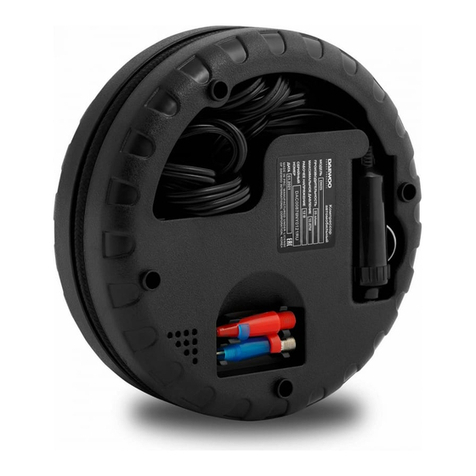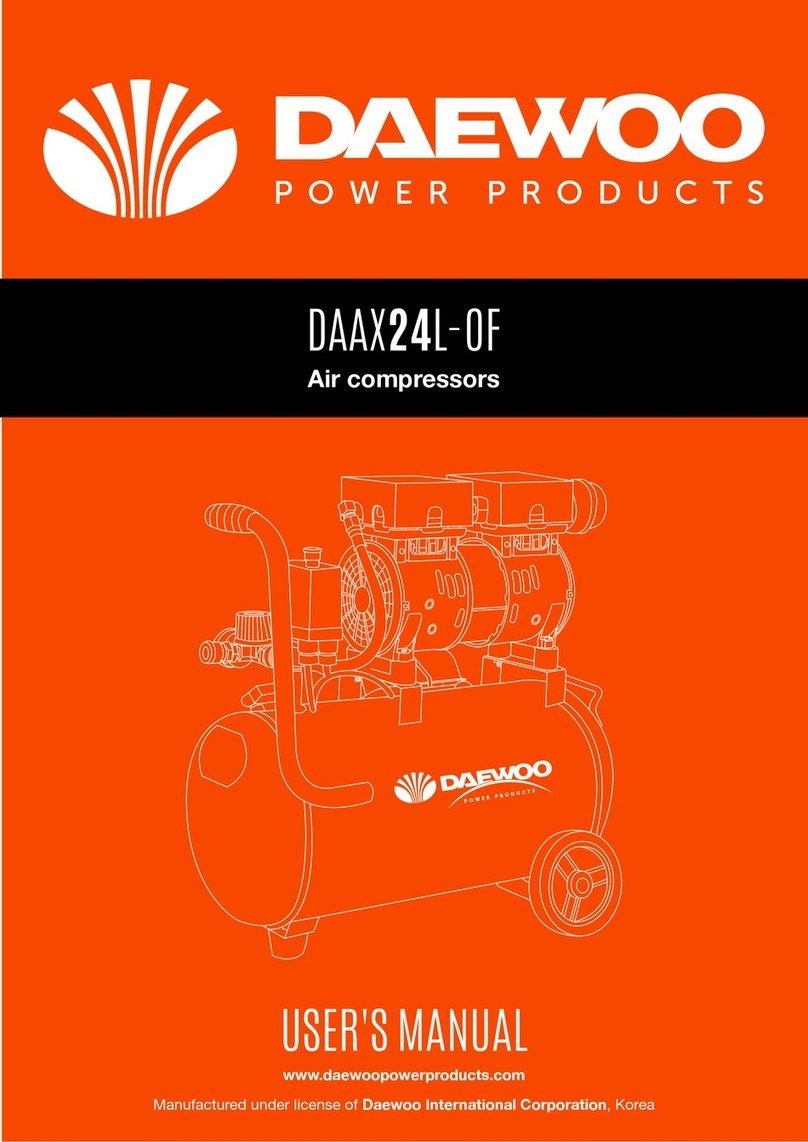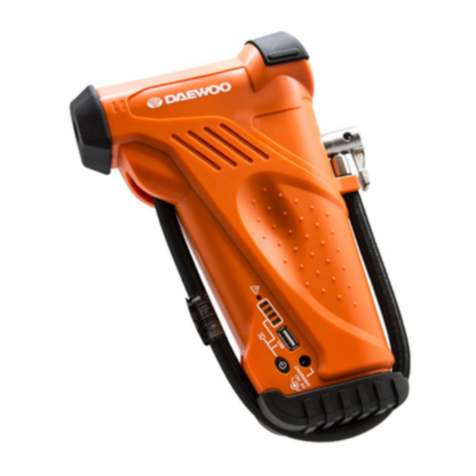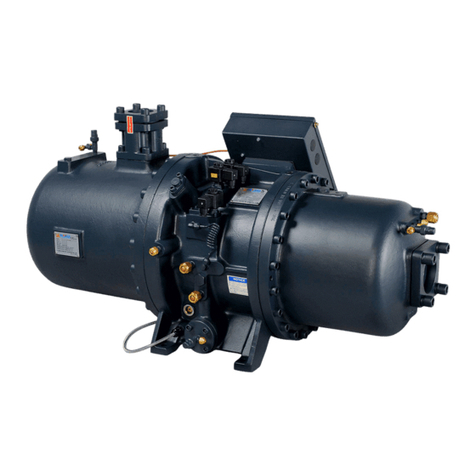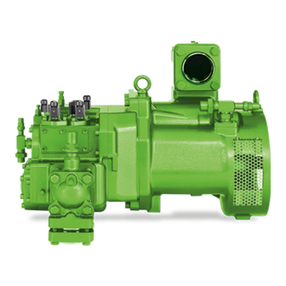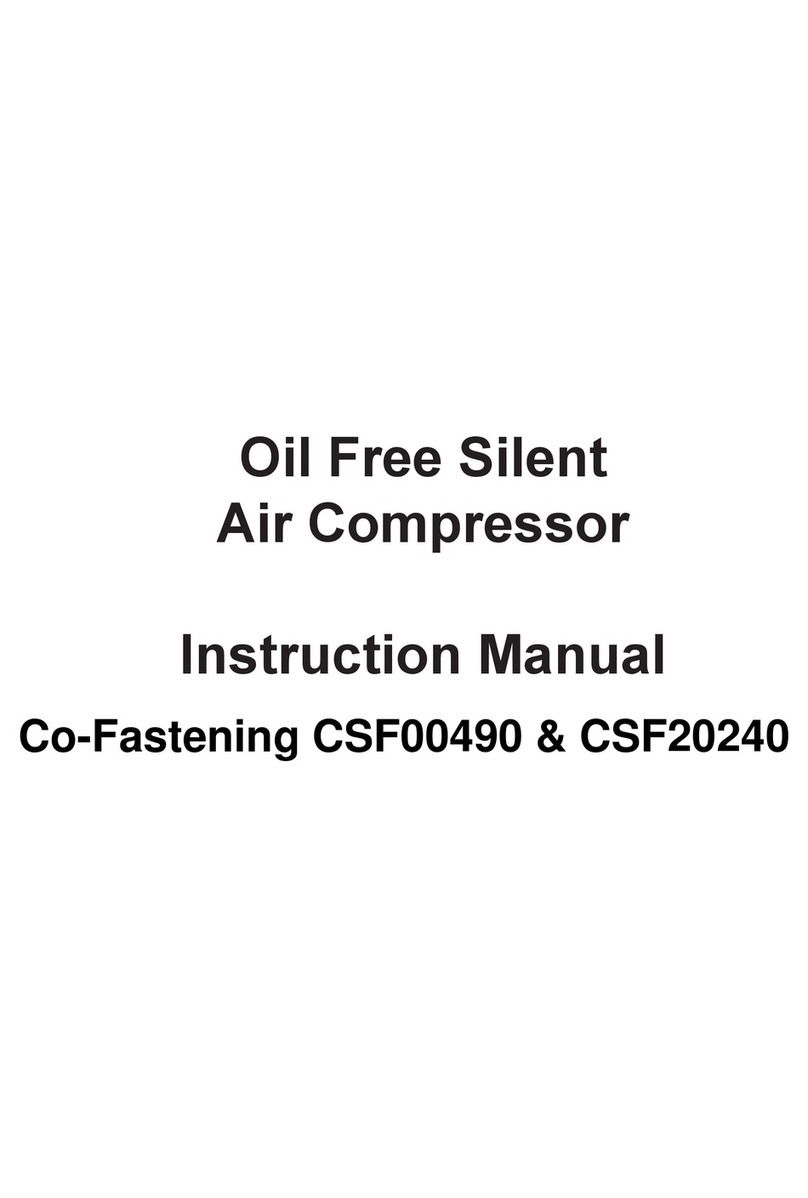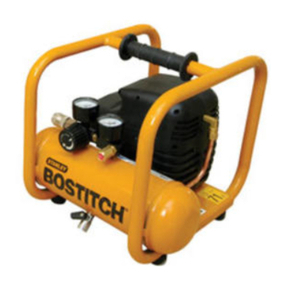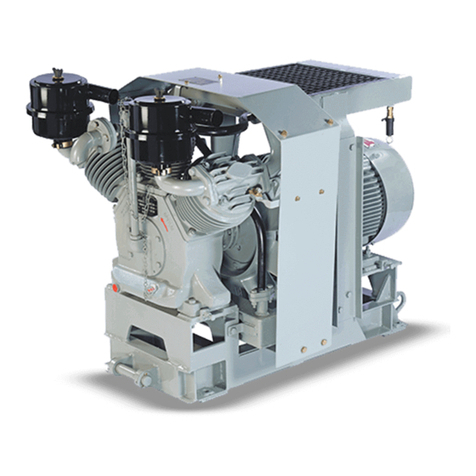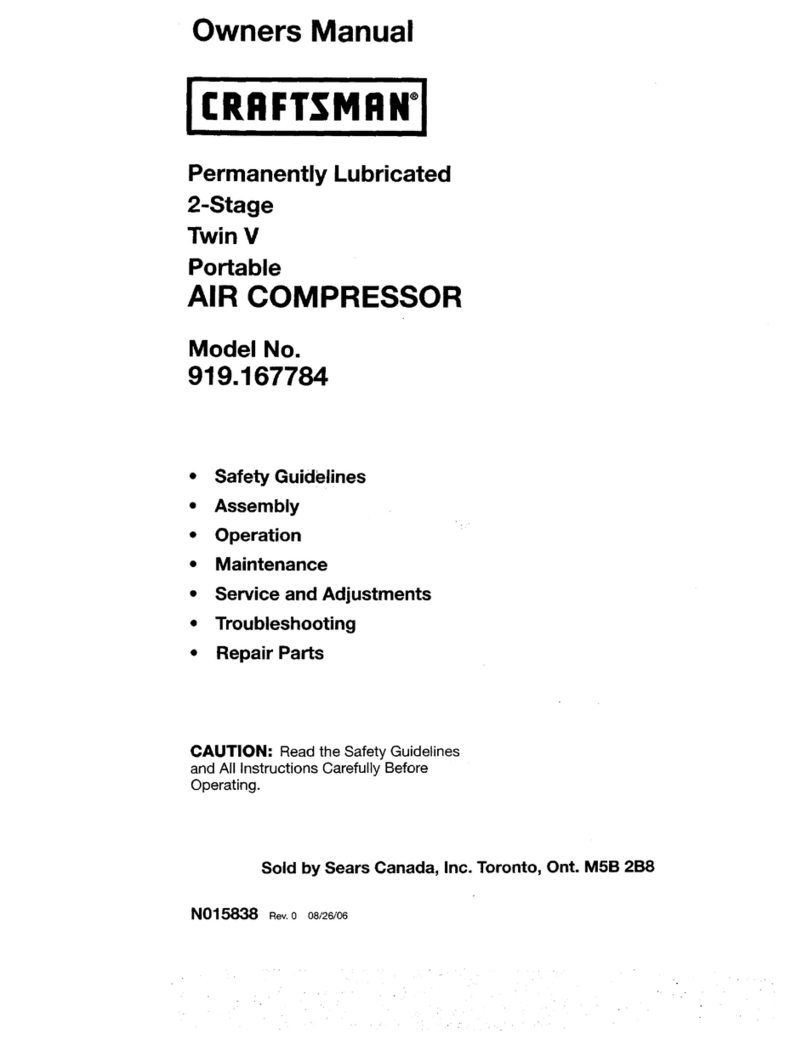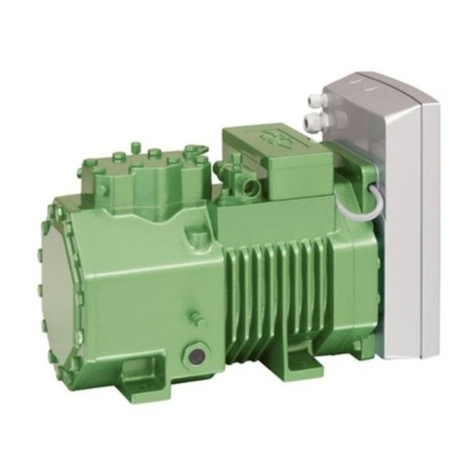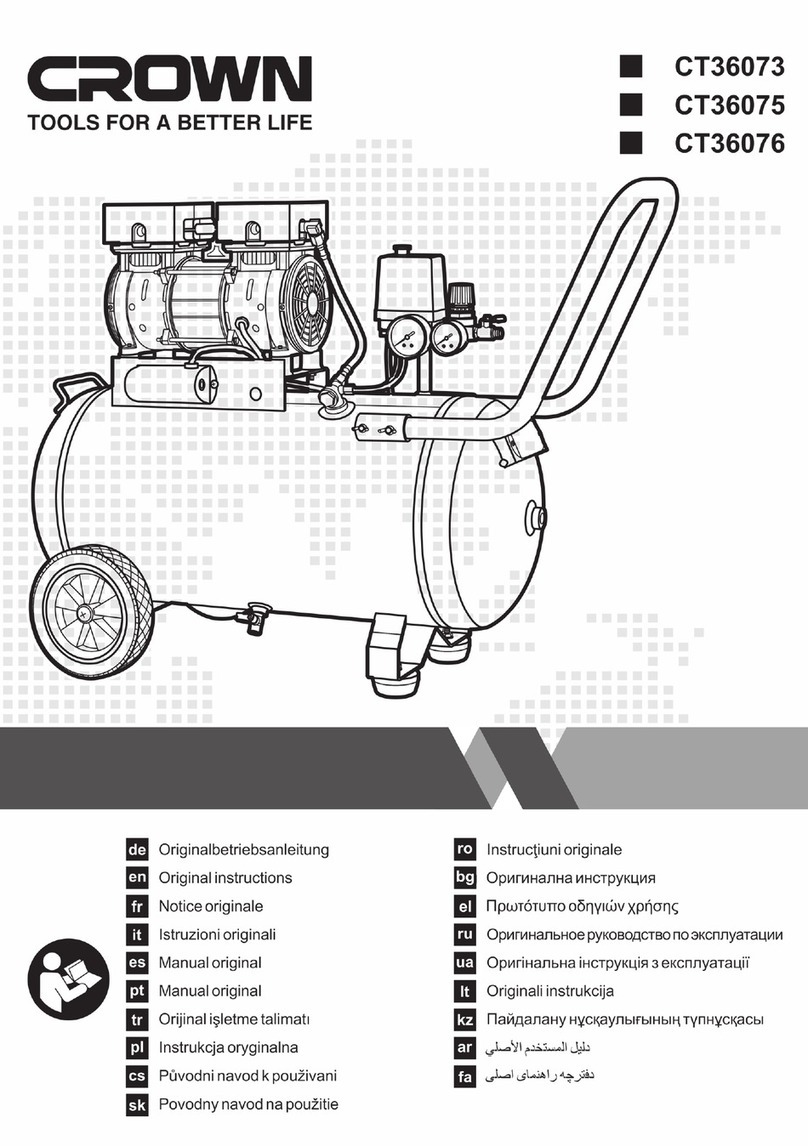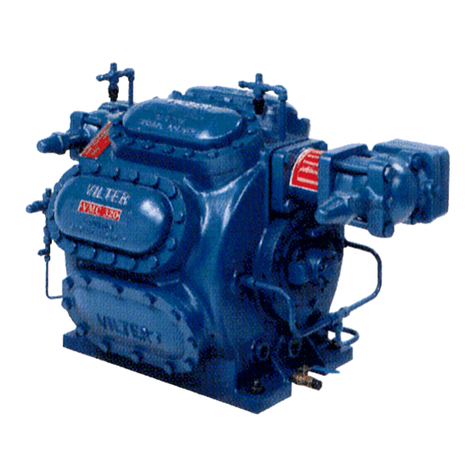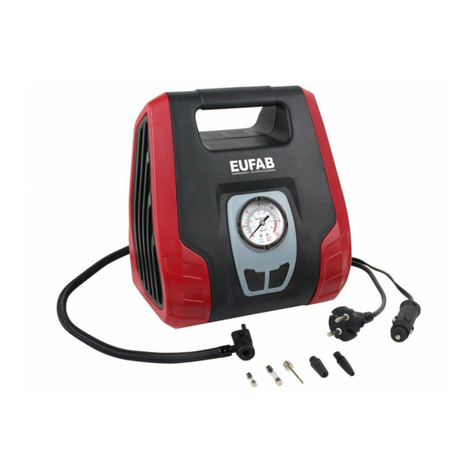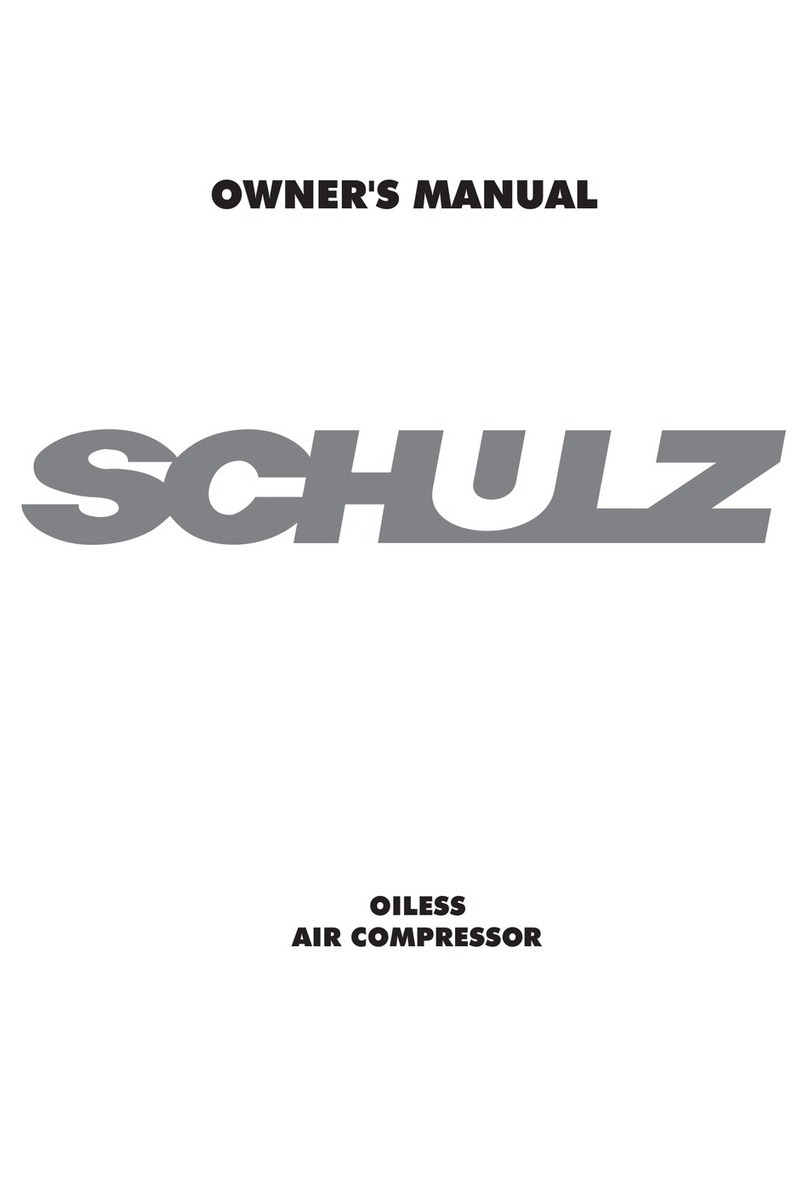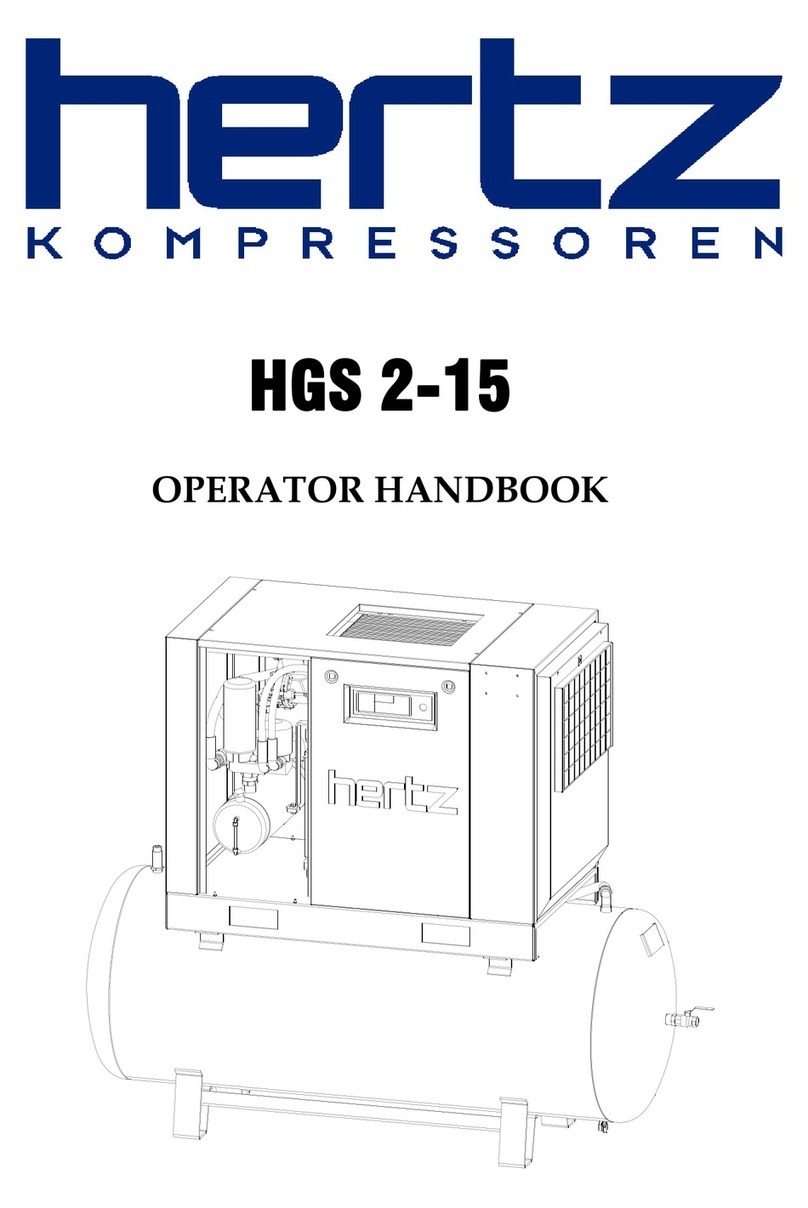Daewoo DAAX500L User manual

Manufactured under license of Daewoo International Corporation, Korea
www.daewoopowerproducts.com
USER'S MANUAL
DAAX500L
Belt air compressor
1. INTRODUCTION
You’ve received the air compressor you had longed for Probably you’ve already had knowledge of it,
but in order to make it serve you always in a good condition, read the manual carefully please.
Operate according to the manual, you’ll get the best economy and efficiency from your new com-
pressor.
Check the compressor when you received it
(1)Make sure it is the model and specification you ordered.
(2)Check the spare parts according to the list attached.
(3)If damage and loosening occurs during the transport, contact the seller please. He will give you a
satisfied solution.
2. SAFETY INFORMATION
2.1 Specified conditions of use
This machine is intended to generate compressed air tools.
Any use for medical purposes, food processing as well as filling of oxygen cylinders for breathing
equipment is not permitted.
Explosive, combustible gases or gases detrimental to health may not be compressed. Operation in
hazardous locations is not permitted.
Any other use is not as specified. Use not as specified, alteration of the machine or use of parts that
are not approved by the equipment manufacturer, can cause unforeseeable damage!
Children, juveniles and persons not having been instructed in its usage are not permitted to operate
this machine and any air tools connected to it.
2.2 General safety information
1 )Keep bystanders, particularly children, out of the work area. Do not permit other persons to touch
the tool or power cable while the machine is running.
(2) Don’t perch on the machine,or use it to hold you
(3) Before each use,inspect compressed air system and electrical components for signs of damage,-
deterioration,weakness or leakage,repair or replace damaged parts before using the equipment
(4) Observe the status accident insurance institution regulations and regulations for the prevention
of accidents pertaining to the operation of air compressors and air tools, where applicable.
(5) To prevent the motor damage by overloading, the compressed air in tank should be released
before operation.
(6) The cylinder head and pipes must be very hot during working, this is normal phenomenon.
(7) To ensure safety, be sure to switch off the power after work or power failure during work.
(8) Be sure to install air switch before connect the power
General hazard!
(1) Keep your work area tidy,a messy work area easy to lead accidents
(2) Consider environmental conditions.
(3) Keep work area well bright.
(4) Do not operate the machine near inflammable liquids or gases.
Danger! Risk of electric shock!
(1) Do not expose the machine to rain.
(2) Do not operate the machine in damp or wet environment.
(3) Prevent body contact with earthed objects such as radiators,pipes,cooking stoves or refrigera-
tors when operating this electric tool
(4) Do not use the power cable for any purpose it is not intended for.
Risk of personal injury by escaping compressed air and parts hurled about by escaping air!
(1) Never direct compressed air against persons or animals!
(2) Ensure all air tools and accessories used are designed for the working pressure or are supplied
via a pressure regulator.
(3) Please note that, when disconnecting the quick coupler, the compressed air contained in the
pressure hose will escape all of a sudden. You should therefore firmly hold the air hose when
disconnecting it
(4) Ensure all screwed connections are fully tightened at all times.
(5) Do not attempt to repair the machine yourself! Only trained specialists are permitted service or
repair compressors
Hazard generated by oil saturated compressed air!
(1) Use oil saturated compressed air only for air tools requiring such supply.
(2) Do not use an air hose used to supply compressed air containing oil to supply air tools not desig-
ned for operation on compressed air containing oil.
(3) Do not fill tires with compressed air containing oil.
Risk of burns from the surfaces of parts carrying compressed air!
Let machine cool off before servicing.
Risk of personal injury and crushing by moving parts!
Please note that the compressor will start automatically when the pressure falls off to minimum!-dis-
connect from power supply prior to any servicing
Hazard generated by insufficient personal protection gear!
(1)Wear hearing protection.
(2)Wear safety glasses.
(3)Wear mask respirator when work generates dust or mist detrimental to health.
(4)Wear suitable work clothes. When working outdoors wearing of nonslip shoes is recommended.
2.3 Safety devices
Safety valve
The safety valve is incorporated into the pressure switch unit,the safety valve opens if the max,per-
missible pressure is exceeded,Will be not accepted adjustment
3. OPERATION
(1) Working place:
*install the compressor in a well ventilated, probably dust and moisture free environment.
*a bright place where oil can be easily added.
*a level place for assemble and check the compressor easily. The belt side should near the wall, but
a distance at least 30cm for the fan’s normal work.
(2)Install wheel
The wheel install includes the following:
-4pcs Wheel(15)
-4pcs key(14)
-4pcs spring washer(16)
Install wheel as illustrated
(3)Install air intake filter
Install air filter on air intake as illustrated
(4)Motor
*Install your own motor that match the compressor.
*Install the V-belt as showed in the figure.
*Adjust belt tension.
The belt must a give of about 10-15mm with a space at it’s center, as showed in the figure:
**Such things may happen if the belt is too tight:
increase the loading, motor get hot, waste energy and
break the belt.
**Such things may happen if the belt is too loose:
sliding produce high temperature, damage the belt,
irregular revolution.
(5)Filling with oil
Remove the oil plug (10)
Fill with oil up to the centre of the level indicator(11)
Install back the oil plug(10)
*The lubricant oil should be of oilness and contain inhibitor, not easy to be oxidized, get densified or
foamed, low residual carbon, hight flash point.
*Oil level should maintain in the red scope of the level glass. Too much oil is a waste, also adsorb
carbon to the valve. Too less oil may cause damage or tear and wear.
*Change oil when it get dark or when greasy dirt is found(about 300 hours operation)
*Loosen the outlet bolt under the bottom of crank case to let the oil out, use paperboard or some-
thing else to facilitate its out, incline forward the compressor also do some help. When all old oil is
out. Tighten the bolt and add new oil to the middle level of the red scope in level glass(to prevent
leakage, apply anti-oxygen glue to the bolt).
*Do not add new oil during running.
*Do not use high viscosity lubricant oil or other waste oil.
(6) Check drain valve
Check to see that the condensate drain’s screw is closed
The working pressure of safety values should be 0.5 - 1kg/ cm² higher than other system.
(7) Mains connection
Danger!High voltage
Operate machine in dry envi-ronment only
Operate machine only on a power source complying with the following requirements
-outlets properly installed, earthed and tested;
-fuse protection in accordance with the Technical Specifications.
Position power cable so it does not interfere with the work and is not damaged.
Always check to see that the machine is switched OFF before plugging in.
Protect power cable from heat, aggressive liquids and sharp edges.
Use only extension cables with sufficient lead cross section(see” Technical Specifications”).
Do not stop the compressor by unplugging, but switch OFF using the switch.
Unplug after use.
(8)Generating compressed air
1.Start compressor(1)and wait until the max. Tank pressure is reached(compressor shuts off).
The tank pressure is indicated by the tank pressure gauge(2).
2. Set pressure regulator(4)to required working pressure. The current working pressure is indicated
by the regulated pressure gauge(17).
Caution!
The regulated pressure may not be set higher than the max.working pressure of the connected air
tools
Connect air hose to compressed air outlet(66)
Connect air tool you are now ready to work with the air tool
Switch the compressor OFF(1) if you do not continue working immediately afterwards,Unplug after
switching OFF
4. GENERAL VIEW AND MAIN COMPONENTS
1. Pressure switch
2. Pressure gauge
3. Quick connector
4. Regulator valve
5. Drain valve
6. Crankcase
7. Air filter
8. Motor
9. Tank
power

INDEX
1
. INTRODUCTION ...................................................................................................................................... 2
2
. SAFETY INFORMATION ..........................................................................................................................
3
. OPERATION ..............................................................................................................................................4
4
. GENERAL VIEW AND MAIN COMPONENTS ........................................................................................
5
. MAIN TECHNICAL PARAMETERS ......................................................................................................... 8
6
. AIR COMPRESSOR PARTS LIST ............................................................................................................9
7
. MAITENANCE ........................................................................................................................................ 11
8
. TROUBLES AND REMEDIES LIST OF GOODS ....................................................................................
WARRANTY ............................................................................................................................................... 18
13
2
8
1
1. INTRODUCTION
You’ve received the air compressor you had longed for Probably you’ve already had knowledge of it,
but in order to make it serve you always in a good condition, read the manual carefully please.
Operate according to the manual, you’ll get the best economy and efficiency from your new com-
pressor.
Check the compressor when you received it
(1)Make sure it is the model and specification you ordered.
(2)Check the spare parts according to the list attached.
(3)If damage and loosening occurs during the transport, contact the seller please. He will give you a
satisfied solution.
2. SAFETY INFORMATION
2.1 Specified conditions of use
This machine is intended to generate compressed air tools.
Any use for medical purposes, food processing as well as filling of oxygen cylinders for breathing
equipment is not permitted.
Explosive, combustible gases or gases detrimental to health may not be compressed. Operation in
hazardous locations is not permitted.
Any other use is not as specified. Use not as specified, alteration of the machine or use of parts that
are not approved by the equipment manufacturer, can cause unforeseeable damage!
Children, juveniles and persons not having been instructed in its usage are not permitted to operate
this machine and any air tools connected to it.
2.2 General safety information
1 )Keep bystanders, particularly children, out of the work area. Do not permit other persons to touch
the tool or power cable while the machine is running.
(2) Don’t perch on the machine,or use it to hold you
(3) Before each use,inspect compressed air system and electrical components for signs of damage,-
deterioration,weakness or leakage,repair or replace damaged parts before using the equipment
(4) Observe the status accident insurance institution regulations and regulations for the prevention
of accidents pertaining to the operation of air compressors and air tools, where applicable.
(5) To prevent the motor damage by overloading, the compressed air in tank should be released
before operation.
(6) The cylinder head and pipes must be very hot during working, this is normal phenomenon.
(7) To ensure safety, be sure to switch off the power after work or power failure during work.
(8) Be sure to install air switch before connect the power
General hazard!
(1) Keep your work area tidy,a messy work area easy to lead accidents
(2) Consider environmental conditions.
(3) Keep work area well bright.
(4) Do not operate the machine near inflammable liquids or gases.
Danger! Risk of electric shock!
(1) Do not expose the machine to rain.
(2) Do not operate the machine in damp or wet environment.
(3) Prevent body contact with earthed objects such as radiators,pipes,cooking stoves or refrigera-
tors when operating this electric tool
(4) Do not use the power cable for any purpose it is not intended for.
Risk of personal injury by escaping compressed air and parts hurled about by escaping air!
(1) Never direct compressed air against persons or animals!
(2) Ensure all air tools and accessories used are designed for the working pressure or are supplied
via a pressure regulator.
(3) Please note that, when disconnecting the quick coupler, the compressed air contained in the
pressure hose will escape all of a sudden. You should therefore firmly hold the air hose when
disconnecting it
(4) Ensure all screwed connections are fully tightened at all times.
(5) Do not attempt to repair the machine yourself! Only trained specialists are permitted service or
repair compressors
Hazard generated by oil saturated compressed air!
(1) Use oil saturated compressed air only for air tools requiring such supply.
(2) Do not use an air hose used to supply compressed air containing oil to supply air tools not desig-
ned for operation on compressed air containing oil.
(3) Do not fill tires with compressed air containing oil.
Risk of burns from the surfaces of parts carrying compressed air!
Let machine cool off before servicing.
Risk of personal injury and crushing by moving parts!
Please note that the compressor will start automatically when the pressure falls off to minimum!-dis-
connect from power supply prior to any servicing
Hazard generated by insufficient personal protection gear!
(1)Wear hearing protection.
(2)Wear safety glasses.
(3)Wear mask respirator when work generates dust or mist detrimental to health.
(4)Wear suitable work clothes. When working outdoors wearing of nonslip shoes is recommended.
2.3 Safety devices
Safety valve
The safety valve is incorporated into the pressure switch unit,the safety valve opens if the max,per-
missible pressure is exceeded,Will be not accepted adjustment
3. OPERATION
(1) Working place:
*install the compressor in a well ventilated, probably dust and moisture free environment.
*a bright place where oil can be easily added.
*a level place for assemble and check the compressor easily. The belt side should near the wall, but
a distance at least 30cm for the fan’s normal work.
(2)Install wheel
The wheel install includes the following:
-4pcs Wheel(15)
-4pcs key(14)
-4pcs spring washer(16)
Install wheel as illustrated
(3)Install air intake filter
Install air filter on air intake as illustrated
(4)Motor
*Install your own motor that match the compressor.
*Install the V-belt as showed in the figure.
*Adjust belt tension.
The belt must a give of about 10-15mm with a space at it’s center, as showed in the figure:
**Such things may happen if the belt is too tight:
increase the loading, motor get hot, waste energy and
break the belt.
**Such things may happen if the belt is too loose:
sliding produce high temperature, damage the belt,
irregular revolution.
(5)Filling with oil
Remove the oil plug (10)
Fill with oil up to the centre of the level indicator(11)
Install back the oil plug(10)
*The lubricant oil should be of oilness and contain inhibitor, not easy to be oxidized, get densified or
foamed, low residual carbon, hight flash point.
*Oil level should maintain in the red scope of the level glass. Too much oil is a waste, also adsorb
carbon to the valve. Too less oil may cause damage or tear and wear.
*Change oil when it get dark or when greasy dirt is found(about 300 hours operation)
*Loosen the outlet bolt under the bottom of crank case to let the oil out, use paperboard or some-
thing else to facilitate its out, incline forward the compressor also do some help. When all old oil is
out. Tighten the bolt and add new oil to the middle level of the red scope in level glass(to prevent
leakage, apply anti-oxygen glue to the bolt).
*Do not add new oil during running.
*Do not use high viscosity lubricant oil or other waste oil.
(6) Check drain valve
Check to see that the condensate drain’s screw is closed
The working pressure of safety values should be 0.5 - 1kg/ cm² higher than other system.
(7) Mains connection
Danger!High voltage
Operate machine in dry envi-ronment only
Operate machine only on a power source complying with the following requirements
-outlets properly installed, earthed and tested;
-fuse protection in accordance with the Technical Specifications.
Position power cable so it does not interfere with the work and is not damaged.
Always check to see that the machine is switched OFF before plugging in.
Protect power cable from heat, aggressive liquids and sharp edges.
Use only extension cables with sufficient lead cross section(see” Technical Specifications”).
Do not stop the compressor by unplugging, but switch OFF using the switch.
Unplug after use.
(8)Generating compressed air
1.Start compressor(1)and wait until the max. Tank pressure is reached(compressor shuts off).
The tank pressure is indicated by the tank pressure gauge(2).
2. Set pressure regulator(4)to required working pressure. The current working pressure is indicated
by the regulated pressure gauge(17).
Caution!
The regulated pressure may not be set higher than the max.working pressure of the connected air
tools
Connect air hose to compressed air outlet(66)
Connect air tool you are now ready to work with the air tool
Switch the compressor OFF(1) if you do not continue working immediately afterwards,Unplug after
switching OFF
4. GENERAL VIEW AND MAIN COMPONENTS
1. Pressure switch
2. Pressure gauge
3. Quick connector
4. Regulator valve
5. Drain valve
6. Crankcase
7. Air filter
8. Motor
9. Tank

2
1. INTRODUCTION
You’ve received the air compressor you had longed for Probably you’ve already had knowledge of it,
but in order to make it serve you always in a good condition, read the manual carefully please.
Operate according to the manual, you’ll get the best economy and efficiency from your new com-
pressor.
Check the compressor when you received it
(1)Make sure it is the model and specification you ordered.
(2)Check the spare parts according to the list attached.
(3)If damage and loosening occurs during the transport, contact the seller please. He will give you a
satisfied solution.
2. SAFETY INFORMATION
2.1 Specified conditions of use
This machine is intended to generate compressed air tools.
Any use for medical purposes, food processing as well as filling of oxygen cylinders for breathing
equipment is not permitted.
Explosive, combustible gases or gases detrimental to health may not be compressed. Operation in
hazardous locations is not permitted.
Any other use is not as specified. Use not as specified, alteration of the machine or use of parts that
are not approved by the equipment manufacturer, can cause unforeseeable damage!
Children, juveniles and persons not having been instructed in its usage are not permitted to operate
this machine and any air tools connected to it.
2.2 General safety information
1 )Keep bystanders, particularly children, out of the work area. Do not permit other persons to touch
the tool or power cable while the machine is running.
(2) Don’t perch on the machine,or use it to hold you
(3) Before each use,inspect compressed air system and electrical components for signs of damage,-
deterioration,weakness or leakage,repair or replace damaged parts before using the equipment
(4) Observe the status accident insurance institution regulations and regulations for the prevention
of accidents pertaining to the operation of air compressors and air tools, where applicable.
(5) To prevent the motor damage by overloading, the compressed air in tank should be released
before operation.
(6) The cylinder head and pipes must be very hot during working, this is normal phenomenon.
(7) To ensure safety, be sure to switch off the power after work or power failure during work.
(8) Be sure to install air switch before connect the power
General hazard!
(1) Keep your work area tidy,a messy work area easy to lead accidents
(2) Consider environmental conditions.
(3) Keep work area well bright.
(4) Do not operate the machine near inflammable liquids or gases.
Danger! Risk of electric shock!
(1) Do not expose the machine to rain.
(2) Do not operate the machine in damp or wet environment.
(3) Prevent body contact with earthed objects such as radiators,pipes,cooking stoves or refrigera-
tors when operating this electric tool
(4) Do not use the power cable for any purpose it is not intended for.
Risk of personal injury by escaping compressed air and parts hurled about by escaping air!
(1) Never direct compressed air against persons or animals!
(2) Ensure all air tools and accessories used are designed for the working pressure or are supplied
via a pressure regulator.
(3) Please note that, when disconnecting the quick coupler, the compressed air contained in the
pressure hose will escape all of a sudden. You should therefore firmly hold the air hose when
disconnecting it
(4) Ensure all screwed connections are fully tightened at all times.
(5) Do not attempt to repair the machine yourself! Only trained specialists are permitted service or
repair compressors
Hazard generated by oil saturated compressed air!
(1) Use oil saturated compressed air only for air tools requiring such supply.
(2) Do not use an air hose used to supply compressed air containing oil to supply air tools not desig-
ned for operation on compressed air containing oil.
(3) Do not fill tires with compressed air containing oil.
Risk of burns from the surfaces of parts carrying compressed air!
Let machine cool off before servicing.
Risk of personal injury and crushing by moving parts!
Please note that the compressor will start automatically when the pressure falls off to minimum!-dis-
connect from power supply prior to any servicing
Hazard generated by insufficient personal protection gear!
(1)Wear hearing protection.
(2)Wear safety glasses.
(3)Wear mask respirator when work generates dust or mist detrimental to health.
(4)Wear suitable work clothes. When working outdoors wearing of nonslip shoes is recommended.
2.3 Safety devices
Safety valve
The safety valve is incorporated into the pressure switch unit,the safety valve opens if the max,per-
missible pressure is exceeded,Will be not accepted adjustment
3. OPERATION
(1) Working place:
*install the compressor in a well ventilated, probably dust and moisture free environment.
*a bright place where oil can be easily added.
*a level place for assemble and check the compressor easily. The belt side should near the wall, but
a distance at least 30cm for the fan’s normal work.
(2)Install wheel
The wheel install includes the following:
-4pcs Wheel(15)
-4pcs key(14)
-4pcs spring washer(16)
Install wheel as illustrated
(3)Install air intake filter
Install air filter on air intake as illustrated
(4)Motor
*Install your own motor that match the compressor.
*Install the V-belt as showed in the figure.
*Adjust belt tension.
The belt must a give of about 10-15mm with a space at it’s center, as showed in the figure:
**Such things may happen if the belt is too tight:
increase the loading, motor get hot, waste energy and
break the belt.
**Such things may happen if the belt is too loose:
sliding produce high temperature, damage the belt,
irregular revolution.
(5)Filling with oil
Remove the oil plug (10)
Fill with oil up to the centre of the level indicator(11)
Install back the oil plug(10)
*The lubricant oil should be of oilness and contain inhibitor, not easy to be oxidized, get densified or
foamed, low residual carbon, hight flash point.
*Oil level should maintain in the red scope of the level glass. Too much oil is a waste, also adsorb
carbon to the valve. Too less oil may cause damage or tear and wear.
*Change oil when it get dark or when greasy dirt is found(about 300 hours operation)
*Loosen the outlet bolt under the bottom of crank case to let the oil out, use paperboard or some-
thing else to facilitate its out, incline forward the compressor also do some help. When all old oil is
out. Tighten the bolt and add new oil to the middle level of the red scope in level glass(to prevent
leakage, apply anti-oxygen glue to the bolt).
*Do not add new oil during running.
*Do not use high viscosity lubricant oil or other waste oil.
(6) Check drain valve
Check to see that the condensate drain’s screw is closed
The working pressure of safety values should be 0.5 - 1kg/ cm² higher than other system.
(7) Mains connection
Danger!High voltage
Operate machine in dry envi-ronment only
Operate machine only on a power source complying with the following requirements
-outlets properly installed, earthed and tested;
-fuse protection in accordance with the Technical Specifications.
Position power cable so it does not interfere with the work and is not damaged.
Always check to see that the machine is switched OFF before plugging in.
Protect power cable from heat, aggressive liquids and sharp edges.
Use only extension cables with sufficient lead cross section(see” Technical Specifications”).
Do not stop the compressor by unplugging, but switch OFF using the switch.
Unplug after use.
(8)Generating compressed air
1.Start compressor(1)and wait until the max. Tank pressure is reached(compressor shuts off).
The tank pressure is indicated by the tank pressure gauge(2).
2. Set pressure regulator(4)to required working pressure. The current working pressure is indicated
by the regulated pressure gauge(17).
Caution!
The regulated pressure may not be set higher than the max.working pressure of the connected air
tools
Connect air hose to compressed air outlet(66)
Connect air tool you are now ready to work with the air tool
Switch the compressor OFF(1) if you do not continue working immediately afterwards,Unplug after
switching OFF
4. GENERAL VIEW AND MAIN COMPONENTS
1. Pressure switch
2. Pressure gauge
3. Quick connector
4. Regulator valve
5. Drain valve
6. Crankcase
7. Air filter
8. Motor
9. Tank

3
1. INTRODUCTION
You’ve received the air compressor you had longed for Probably you’ve already had knowledge of it,
but in order to make it serve you always in a good condition, read the manual carefully please.
Operate according to the manual, you’ll get the best economy and efficiency from your new com-
pressor.
Check the compressor when you received it
(1)Make sure it is the model and specification you ordered.
(2)Check the spare parts according to the list attached.
(3)If damage and loosening occurs during the transport, contact the seller please. He will give you a
satisfied solution.
2. SAFETY INFORMATION
2.1 Specified conditions of use
This machine is intended to generate compressed air tools.
Any use for medical purposes, food processing as well as filling of oxygen cylinders for breathing
equipment is not permitted.
Explosive, combustible gases or gases detrimental to health may not be compressed. Operation in
hazardous locations is not permitted.
Any other use is not as specified. Use not as specified, alteration of the machine or use of parts that
are not approved by the equipment manufacturer, can cause unforeseeable damage!
Children, juveniles and persons not having been instructed in its usage are not permitted to operate
this machine and any air tools connected to it.
2.2 General safety information
1 )Keep bystanders, particularly children, out of the work area. Do not permit other persons to touch
the tool or power cable while the machine is running.
(2) Don’t perch on the machine,or use it to hold you
(3) Before each use,inspect compressed air system and electrical components for signs of damage,-
deterioration,weakness or leakage,repair or replace damaged parts before using the equipment
(4) Observe the status accident insurance institution regulations and regulations for the prevention
of accidents pertaining to the operation of air compressors and air tools, where applicable.
(5) To prevent the motor damage by overloading, the compressed air in tank should be released
before operation.
(6) The cylinder head and pipes must be very hot during working, this is normal phenomenon.
(7) To ensure safety, be sure to switch off the power after work or power failure during work.
(8) Be sure to install air switch before connect the power
General hazard!
(1) Keep your work area tidy,a messy work area easy to lead accidents
(2) Consider environmental conditions.
(3) Keep work area well bright.
(4) Do not operate the machine near inflammable liquids or gases.
Danger! Risk of electric shock!
(1) Do not expose the machine to rain.
(2) Do not operate the machine in damp or wet environment.
(3) Prevent body contact with earthed objects such as radiators,pipes,cooking stoves or refrigera-
tors when operating this electric tool
(4) Do not use the power cable for any purpose it is not intended for.
Risk of personal injury by escaping compressed air and parts hurled about by escaping air!
(1) Never direct compressed air against persons or animals!
(2) Ensure all air tools and accessories used are designed for the working pressure or are supplied
via a pressure regulator.
(3) Please note that, when disconnecting the quick coupler, the compressed air contained in the
pressure hose will escape all of a sudden. You should therefore firmly hold the air hose when
disconnecting it
(4) Ensure all screwed connections are fully tightened at all times.
(5) Do not attempt to repair the machine yourself! Only trained specialists are permitted service or
repair compressors
Hazard generated by oil saturated compressed air!
(1) Use oil saturated compressed air only for air tools requiring such supply.
(2) Do not use an air hose used to supply compressed air containing oil to supply air tools not desig-
ned for operation on compressed air containing oil.
(3) Do not fill tires with compressed air containing oil.
Risk of burns from the surfaces of parts carrying compressed air!
Let machine cool off before servicing.
Risk of personal injury and crushing by moving parts!
Please note that the compressor will start automatically when the pressure falls off to minimum!-dis-
connect from power supply prior to any servicing
Hazard generated by insufficient personal protection gear!
(1)Wear hearing protection.
(2)Wear safety glasses.
(3)Wear mask respirator when work generates dust or mist detrimental to health.
(4)Wear suitable work clothes. When working outdoors wearing of nonslip shoes is recommended.
2.3 Safety devices
Safety valve
13
The safety valve is incorporated into the pressure switch unit,the safety valve opens if the max,per-
missible pressure is exceeded,Will be not accepted adjustment
3. OPERATION
(1) Working place:
*install the compressor in a well ventilated, probably dust and moisture free environment.
*a bright place where oil can be easily added.
*a level place for assemble and check the compressor easily. The belt side should near the wall, but
a distance at least 30cm for the fan’s normal work.
(2)Install wheel
The wheel install includes the following:
-4pcs Wheel(15)
-4pcs key(14)
-4pcs spring washer(16)
Install wheel as illustrated
(3)Install air intake filter
Install air filter on air intake as illustrated
(4)Motor
*Install your own motor that match the compressor.
*Install the V-belt as showed in the figure.
*Adjust belt tension.
The belt must a give of about 10-15mm with a space at it’s center, as showed in the figure:
**Such things may happen if the belt is too tight:
increase the loading, motor get hot, waste energy and
break the belt.
**Such things may happen if the belt is too loose:
sliding produce high temperature, damage the belt,
irregular revolution.
(5)Filling with oil
Remove the oil plug (10)
Fill with oil up to the centre of the level indicator(11)
Install back the oil plug(10)
*The lubricant oil should be of oilness and contain inhibitor, not easy to be oxidized, get densified or
foamed, low residual carbon, hight flash point.
*Oil level should maintain in the red scope of the level glass. Too much oil is a waste, also adsorb
carbon to the valve. Too less oil may cause damage or tear and wear.
*Change oil when it get dark or when greasy dirt is found(about 300 hours operation)
*Loosen the outlet bolt under the bottom of crank case to let the oil out, use paperboard or some-
thing else to facilitate its out, incline forward the compressor also do some help. When all old oil is
out. Tighten the bolt and add new oil to the middle level of the red scope in level glass(to prevent
leakage, apply anti-oxygen glue to the bolt).
*Do not add new oil during running.
*Do not use high viscosity lubricant oil or other waste oil.
(6) Check drain valve
Check to see that the condensate drain’s screw is closed
The working pressure of safety values should be 0.5 - 1kg/ cm² higher than other system.
(7) Mains connection
Danger!High voltage
Operate machine in dry envi-ronment only
Operate machine only on a power source complying with the following requirements
-outlets properly installed, earthed and tested;
-fuse protection in accordance with the Technical Specifications.
Position power cable so it does not interfere with the work and is not damaged.
Always check to see that the machine is switched OFF before plugging in.
Protect power cable from heat, aggressive liquids and sharp edges.
Use only extension cables with sufficient lead cross section(see” Technical Specifications”).
Do not stop the compressor by unplugging, but switch OFF using the switch.
Unplug after use.
(8)Generating compressed air
1.Start compressor(1)and wait until the max. Tank pressure is reached(compressor shuts off).
The tank pressure is indicated by the tank pressure gauge(2).
2. Set pressure regulator(4)to required working pressure. The current working pressure is indicated
by the regulated pressure gauge(17).
Caution!
The regulated pressure may not be set higher than the max.working pressure of the connected air
tools
Connect air hose to compressed air outlet(66)
Connect air tool you are now ready to work with the air tool
Switch the compressor OFF(1) if you do not continue working immediately afterwards,Unplug after
switching OFF
4. GENERAL VIEW AND MAIN COMPONENTS
1. Pressure switch
2. Pressure gauge
3. Quick connector
4. Regulator valve
5. Drain valve
6. Crankcase
7. Air filter
8. Motor
9. Tank

4
1. INTRODUCTION
You’ve received the air compressor you had longed for Probably you’ve already had knowledge of it,
but in order to make it serve you always in a good condition, read the manual carefully please.
Operate according to the manual, you’ll get the best economy and efficiency from your new com-
pressor.
Check the compressor when you received it
(1)Make sure it is the model and specification you ordered.
(2)Check the spare parts according to the list attached.
(3)If damage and loosening occurs during the transport, contact the seller please. He will give you a
satisfied solution.
2. SAFETY INFORMATION
2.1 Specified conditions of use
This machine is intended to generate compressed air tools.
Any use for medical purposes, food processing as well as filling of oxygen cylinders for breathing
equipment is not permitted.
Explosive, combustible gases or gases detrimental to health may not be compressed. Operation in
hazardous locations is not permitted.
Any other use is not as specified. Use not as specified, alteration of the machine or use of parts that
are not approved by the equipment manufacturer, can cause unforeseeable damage!
Children, juveniles and persons not having been instructed in its usage are not permitted to operate
this machine and any air tools connected to it.
2.2 General safety information
1 )Keep bystanders, particularly children, out of the work area. Do not permit other persons to touch
the tool or power cable while the machine is running.
(2) Don’t perch on the machine,or use it to hold you
(3) Before each use,inspect compressed air system and electrical components for signs of damage,-
deterioration,weakness or leakage,repair or replace damaged parts before using the equipment
(4) Observe the status accident insurance institution regulations and regulations for the prevention
of accidents pertaining to the operation of air compressors and air tools, where applicable.
(5) To prevent the motor damage by overloading, the compressed air in tank should be released
before operation.
(6) The cylinder head and pipes must be very hot during working, this is normal phenomenon.
(7) To ensure safety, be sure to switch off the power after work or power failure during work.
(8) Be sure to install air switch before connect the power
General hazard!
(1) Keep your work area tidy,a messy work area easy to lead accidents
(2) Consider environmental conditions.
(3) Keep work area well bright.
(4) Do not operate the machine near inflammable liquids or gases.
Danger! Risk of electric shock!
(1) Do not expose the machine to rain.
(2) Do not operate the machine in damp or wet environment.
(3) Prevent body contact with earthed objects such as radiators,pipes,cooking stoves or refrigera-
tors when operating this electric tool
(4) Do not use the power cable for any purpose it is not intended for.
Risk of personal injury by escaping compressed air and parts hurled about by escaping air!
(1) Never direct compressed air against persons or animals!
(2) Ensure all air tools and accessories used are designed for the working pressure or are supplied
via a pressure regulator.
(3) Please note that, when disconnecting the quick coupler, the compressed air contained in the
pressure hose will escape all of a sudden. You should therefore firmly hold the air hose when
disconnecting it
(4) Ensure all screwed connections are fully tightened at all times.
(5) Do not attempt to repair the machine yourself! Only trained specialists are permitted service or
repair compressors
Hazard generated by oil saturated compressed air!
(1) Use oil saturated compressed air only for air tools requiring such supply.
(2) Do not use an air hose used to supply compressed air containing oil to supply air tools not desig-
ned for operation on compressed air containing oil.
(3) Do not fill tires with compressed air containing oil.
Risk of burns from the surfaces of parts carrying compressed air!
Let machine cool off before servicing.
Risk of personal injury and crushing by moving parts!
Please note that the compressor will start automatically when the pressure falls off to minimum!-dis-
connect from power supply prior to any servicing
Hazard generated by insufficient personal protection gear!
(1)Wear hearing protection.
(2)Wear safety glasses.
(3)Wear mask respirator when work generates dust or mist detrimental to health.
(4)Wear suitable work clothes. When working outdoors wearing of nonslip shoes is recommended.
2.3 Safety devices
Safety valve
The safety valve is incorporated into the pressure switch unit,the safety valve opens if the max,per-
missible pressure is exceeded,Will be not accepted adjustment
3. OPERATION
(1) Working place:
*install the compressor in a well ventilated, probably dust and moisture free environment.
*a bright place where oil can be easily added.
*a level place for assemble and check the compressor easily. The belt side should near the wall, but
a distance at least 30cm for the fan’s normal work.
(2)Install wheel
The wheel install includes the following:
-4pcs Wheel(15)
-4pcs key(14)
-4pcs spring washer(16)
Install wheel as illustrated
(3)Install air intake filter
Install air filter on air intake as illustrated
14
15
16
(4)Motor
*Install your own motor that match the compressor.
*Install the V-belt as showed in the figure.
*Adjust belt tension.
The belt must a give of about 10-15mm with a space at it’s center, as showed in the figure:
**Such things may happen if the belt is too tight:
increase the loading, motor get hot, waste energy and
break the belt.
**Such things may happen if the belt is too loose:
sliding produce high temperature, damage the belt,
irregular revolution.
(5)Filling with oil
Remove the oil plug (10)
Fill with oil up to the centre of the level indicator(11)
Install back the oil plug(10)
*The lubricant oil should be of oilness and contain inhibitor, not easy to be oxidized, get densified or
foamed, low residual carbon, hight flash point.
*Oil level should maintain in the red scope of the level glass. Too much oil is a waste, also adsorb
carbon to the valve. Too less oil may cause damage or tear and wear.
*Change oil when it get dark or when greasy dirt is found(about 300 hours operation)
*Loosen the outlet bolt under the bottom of crank case to let the oil out, use paperboard or some-
thing else to facilitate its out, incline forward the compressor also do some help. When all old oil is
out. Tighten the bolt and add new oil to the middle level of the red scope in level glass(to prevent
leakage, apply anti-oxygen glue to the bolt).
*Do not add new oil during running.
*Do not use high viscosity lubricant oil or other waste oil.
(6) Check drain valve
Check to see that the condensate drain’s screw is closed
The working pressure of safety values should be 0.5 - 1kg/ cm² higher than other system.
(7) Mains connection
Danger!High voltage
Operate machine in dry envi-ronment only
Operate machine only on a power source complying with the following requirements
-outlets properly installed, earthed and tested;
-fuse protection in accordance with the Technical Specifications.
Position power cable so it does not interfere with the work and is not damaged.
Always check to see that the machine is switched OFF before plugging in.
Protect power cable from heat, aggressive liquids and sharp edges.
Use only extension cables with sufficient lead cross section(see” Technical Specifications”).
Do not stop the compressor by unplugging, but switch OFF using the switch.
Unplug after use.
(8)Generating compressed air
1.Start compressor(1)and wait until the max. Tank pressure is reached(compressor shuts off).
The tank pressure is indicated by the tank pressure gauge(2).
2. Set pressure regulator(4)to required working pressure. The current working pressure is indicated
by the regulated pressure gauge(17).
Caution!
The regulated pressure may not be set higher than the max.working pressure of the connected air
tools
Connect air hose to compressed air outlet(66)
Connect air tool you are now ready to work with the air tool
Switch the compressor OFF(1) if you do not continue working immediately afterwards,Unplug after
switching OFF
4. GENERAL VIEW AND MAIN COMPONENTS
1. Pressure switch
2. Pressure gauge
3. Quick connector
4. Regulator valve
5. Drain valve
6. Crankcase
7. Air filter
8. Motor
9. Tank

5
1. INTRODUCTION
You’ve received the air compressor you had longed for Probably you’ve already had knowledge of it,
but in order to make it serve you always in a good condition, read the manual carefully please.
Operate according to the manual, you’ll get the best economy and efficiency from your new com-
pressor.
Check the compressor when you received it
(1)Make sure it is the model and specification you ordered.
(2)Check the spare parts according to the list attached.
(3)If damage and loosening occurs during the transport, contact the seller please. He will give you a
satisfied solution.
2. SAFETY INFORMATION
2.1 Specified conditions of use
This machine is intended to generate compressed air tools.
Any use for medical purposes, food processing as well as filling of oxygen cylinders for breathing
equipment is not permitted.
Explosive, combustible gases or gases detrimental to health may not be compressed. Operation in
hazardous locations is not permitted.
Any other use is not as specified. Use not as specified, alteration of the machine or use of parts that
are not approved by the equipment manufacturer, can cause unforeseeable damage!
Children, juveniles and persons not having been instructed in its usage are not permitted to operate
this machine and any air tools connected to it.
2.2 General safety information
1 )Keep bystanders, particularly children, out of the work area. Do not permit other persons to touch
the tool or power cable while the machine is running.
(2) Don’t perch on the machine,or use it to hold you
(3) Before each use,inspect compressed air system and electrical components for signs of damage,-
deterioration,weakness or leakage,repair or replace damaged parts before using the equipment
(4) Observe the status accident insurance institution regulations and regulations for the prevention
of accidents pertaining to the operation of air compressors and air tools, where applicable.
(5) To prevent the motor damage by overloading, the compressed air in tank should be released
before operation.
(6) The cylinder head and pipes must be very hot during working, this is normal phenomenon.
(7) To ensure safety, be sure to switch off the power after work or power failure during work.
(8) Be sure to install air switch before connect the power
General hazard!
(1) Keep your work area tidy,a messy work area easy to lead accidents
(2) Consider environmental conditions.
(3) Keep work area well bright.
(4) Do not operate the machine near inflammable liquids or gases.
Danger! Risk of electric shock!
(1) Do not expose the machine to rain.
(2) Do not operate the machine in damp or wet environment.
(3) Prevent body contact with earthed objects such as radiators,pipes,cooking stoves or refrigera-
tors when operating this electric tool
(4) Do not use the power cable for any purpose it is not intended for.
Risk of personal injury by escaping compressed air and parts hurled about by escaping air!
(1) Never direct compressed air against persons or animals!
(2) Ensure all air tools and accessories used are designed for the working pressure or are supplied
via a pressure regulator.
(3) Please note that, when disconnecting the quick coupler, the compressed air contained in the
pressure hose will escape all of a sudden. You should therefore firmly hold the air hose when
disconnecting it
(4) Ensure all screwed connections are fully tightened at all times.
(5) Do not attempt to repair the machine yourself! Only trained specialists are permitted service or
repair compressors
Hazard generated by oil saturated compressed air!
(1) Use oil saturated compressed air only for air tools requiring such supply.
(2) Do not use an air hose used to supply compressed air containing oil to supply air tools not desig-
ned for operation on compressed air containing oil.
(3) Do not fill tires with compressed air containing oil.
Risk of burns from the surfaces of parts carrying compressed air!
Let machine cool off before servicing.
Risk of personal injury and crushing by moving parts!
Please note that the compressor will start automatically when the pressure falls off to minimum!-dis-
connect from power supply prior to any servicing
Hazard generated by insufficient personal protection gear!
(1)Wear hearing protection.
(2)Wear safety glasses.
(3)Wear mask respirator when work generates dust or mist detrimental to health.
(4)Wear suitable work clothes. When working outdoors wearing of nonslip shoes is recommended.
2.3 Safety devices
Safety valve
The safety valve is incorporated into the pressure switch unit,the safety valve opens if the max,per-
missible pressure is exceeded,Will be not accepted adjustment
3. OPERATION
(1) Working place:
*install the compressor in a well ventilated, probably dust and moisture free environment.
*a bright place where oil can be easily added.
*a level place for assemble and check the compressor easily. The belt side should near the wall, but
a distance at least 30cm for the fan’s normal work.
(2)Install wheel
The wheel install includes the following:
-4pcs Wheel(15)
-4pcs key(14)
-4pcs spring washer(16)
Install wheel as illustrated
(3)Install air intake filter
Install air filter on air intake as illustrated
(4)Motor
*Install your own motor that match the compressor.
*Install the V-belt as showed in the figure.
*Adjust belt tension.
The belt must a give of about 10-15mm with a space at it’s center, as showed in the figure:
**Such things may happen if the belt is too tight:
increase the loading, motor get hot, waste energy and
break the belt.
**Such things may happen if the belt is too loose:
sliding produce high temperature, damage the belt,
irregular revolution.
(5)Filling with oil
Remove the oil plug (10)
Fill with oil up to the centre of the level indicator(11)
Install back the oil plug(10)
*The lubricant oil should be of oilness and contain inhibitor, not easy to be oxidized, get densified or
foamed, low residual carbon, hight flash point.
*Oil level should maintain in the red scope of the level glass. Too much oil is a waste, also adsorb
carbon to the valve. Too less oil may cause damage or tear and wear.
*Change oil when it get dark or when greasy dirt is found(about 300 hours operation)
*Loosen the outlet bolt under the bottom of crank case to let the oil out, use paperboard or some-
thing else to facilitate its out, incline forward the compressor also do some help. When all old oil is
out. Tighten the bolt and add new oil to the middle level of the red scope in level glass(to prevent
leakage, apply anti-oxygen glue to the bolt).
*Do not add new oil during running.
*Do not use high viscosity lubricant oil or other waste oil.
(6) Check drain valve
Check to see that the condensate drain’s screw is closed
The working pressure of safety values should be 0.5 - 1kg/ cm² higher than other system.
(7) Mains connection
Danger!High voltage
Operate machine in dry envi-ronment only
Operate machine only on a power source complying with the following requirements
-outlets properly installed, earthed and tested;
-fuse protection in accordance with the Technical Specifications.
Position power cable so it does not interfere with the work and is not damaged.
Always check to see that the machine is switched OFF before plugging in.
Protect power cable from heat, aggressive liquids and sharp edges.
Use only extension cables with sufficient lead cross section(see” Technical Specifications”).
Do not stop the compressor by unplugging, but switch OFF using the switch.
Unplug after use.
(8)Generating compressed air
1.Start compressor(1)and wait until the max. Tank pressure is reached(compressor shuts off).
The tank pressure is indicated by the tank pressure gauge(2).
2. Set pressure regulator(4)to required working pressure. The current working pressure is indicated
by the regulated pressure gauge(17).
Caution!
The regulated pressure may not be set higher than the max.working pressure of the connected air
tools
Connect air hose to compressed air outlet(66)
Connect air tool you are now ready to work with the air tool
Switch the compressor OFF(1) if you do not continue working immediately afterwards,Unplug after
switching OFF
4. GENERAL VIEW AND MAIN COMPONENTS
1. Pressure switch
2. Pressure gauge
3. Quick connector
4. Regulator valve
5. Drain valve
6. Crankcase
7. Air filter
8. Motor
9. Tank

6
1. INTRODUCTION
You’ve received the air compressor you had longed for Probably you’ve already had knowledge of it,
but in order to make it serve you always in a good condition, read the manual carefully please.
Operate according to the manual, you’ll get the best economy and efficiency from your new com-
pressor.
Check the compressor when you received it
(1)Make sure it is the model and specification you ordered.
(2)Check the spare parts according to the list attached.
(3)If damage and loosening occurs during the transport, contact the seller please. He will give you a
satisfied solution.
2. SAFETY INFORMATION
2.1 Specified conditions of use
This machine is intended to generate compressed air tools.
Any use for medical purposes, food processing as well as filling of oxygen cylinders for breathing
equipment is not permitted.
Explosive, combustible gases or gases detrimental to health may not be compressed. Operation in
hazardous locations is not permitted.
Any other use is not as specified. Use not as specified, alteration of the machine or use of parts that
are not approved by the equipment manufacturer, can cause unforeseeable damage!
Children, juveniles and persons not having been instructed in its usage are not permitted to operate
this machine and any air tools connected to it.
2.2 General safety information
1 )Keep bystanders, particularly children, out of the work area. Do not permit other persons to touch
the tool or power cable while the machine is running.
(2) Don’t perch on the machine,or use it to hold you
(3) Before each use,inspect compressed air system and electrical components for signs of damage,-
deterioration,weakness or leakage,repair or replace damaged parts before using the equipment
(4) Observe the status accident insurance institution regulations and regulations for the prevention
of accidents pertaining to the operation of air compressors and air tools, where applicable.
(5) To prevent the motor damage by overloading, the compressed air in tank should be released
before operation.
(6) The cylinder head and pipes must be very hot during working, this is normal phenomenon.
(7) To ensure safety, be sure to switch off the power after work or power failure during work.
(8) Be sure to install air switch before connect the power
General hazard!
(1) Keep your work area tidy,a messy work area easy to lead accidents
(2) Consider environmental conditions.
(3) Keep work area well bright.
(4) Do not operate the machine near inflammable liquids or gases.
Danger! Risk of electric shock!
(1) Do not expose the machine to rain.
(2) Do not operate the machine in damp or wet environment.
(3) Prevent body contact with earthed objects such as radiators,pipes,cooking stoves or refrigera-
tors when operating this electric tool
(4) Do not use the power cable for any purpose it is not intended for.
Risk of personal injury by escaping compressed air and parts hurled about by escaping air!
(1) Never direct compressed air against persons or animals!
(2) Ensure all air tools and accessories used are designed for the working pressure or are supplied
via a pressure regulator.
(3) Please note that, when disconnecting the quick coupler, the compressed air contained in the
pressure hose will escape all of a sudden. You should therefore firmly hold the air hose when
disconnecting it
(4) Ensure all screwed connections are fully tightened at all times.
(5) Do not attempt to repair the machine yourself! Only trained specialists are permitted service or
repair compressors
Hazard generated by oil saturated compressed air!
(1) Use oil saturated compressed air only for air tools requiring such supply.
(2) Do not use an air hose used to supply compressed air containing oil to supply air tools not desig-
ned for operation on compressed air containing oil.
(3) Do not fill tires with compressed air containing oil.
Risk of burns from the surfaces of parts carrying compressed air!
Let machine cool off before servicing.
Risk of personal injury and crushing by moving parts!
Please note that the compressor will start automatically when the pressure falls off to minimum!-dis-
connect from power supply prior to any servicing
Hazard generated by insufficient personal protection gear!
(1)Wear hearing protection.
(2)Wear safety glasses.
(3)Wear mask respirator when work generates dust or mist detrimental to health.
(4)Wear suitable work clothes. When working outdoors wearing of nonslip shoes is recommended.
2.3 Safety devices
Safety valve
The safety valve is incorporated into the pressure switch unit,the safety valve opens if the max,per-
missible pressure is exceeded,Will be not accepted adjustment
3. OPERATION
(1) Working place:
*install the compressor in a well ventilated, probably dust and moisture free environment.
*a bright place where oil can be easily added.
*a level place for assemble and check the compressor easily. The belt side should near the wall, but
a distance at least 30cm for the fan’s normal work.
(2)Install wheel
The wheel install includes the following:
-4pcs Wheel(15)
-4pcs key(14)
-4pcs spring washer(16)
Install wheel as illustrated
(3)Install air intake filter
Install air filter on air intake as illustrated
(4)Motor
*Install your own motor that match the compressor.
*Install the V-belt as showed in the figure.
*Adjust belt tension.
The belt must a give of about 10-15mm with a space at it’s center, as showed in the figure:
**Such things may happen if the belt is too tight:
increase the loading, motor get hot, waste energy and
break the belt.
**Such things may happen if the belt is too loose:
sliding produce high temperature, damage the belt,
irregular revolution.
(5)Filling with oil
Remove the oil plug (10)
Fill with oil up to the centre of the level indicator(11)
Install back the oil plug(10)
*The lubricant oil should be of oilness and contain inhibitor, not easy to be oxidized, get densified or
foamed, low residual carbon, hight flash point.
*Oil level should maintain in the red scope of the level glass. Too much oil is a waste, also adsorb
carbon to the valve. Too less oil may cause damage or tear and wear.
*Change oil when it get dark or when greasy dirt is found(about 300 hours operation)
*Loosen the outlet bolt under the bottom of crank case to let the oil out, use paperboard or some-
thing else to facilitate its out, incline forward the compressor also do some help. When all old oil is
out. Tighten the bolt and add new oil to the middle level of the red scope in level glass(to prevent
leakage, apply anti-oxygen glue to the bolt).
*Do not add new oil during running.
*Do not use high viscosity lubricant oil or other waste oil.
(6) Check drain valve
Check to see that the condensate drain’s screw is closed
The working pressure of safety values should be 0.5 - 1kg/ cm² higher than other system.
(7) Mains connection
Danger!High voltage
Operate machine in dry envi-ronment only
Operate machine only on a power source complying with the following requirements
-outlets properly installed, earthed and tested;
-fuse protection in accordance with the Technical Specifications.
Position power cable so it does not interfere with the work and is not damaged.
Always check to see that the machine is switched OFF before plugging in.
Protect power cable from heat, aggressive liquids and sharp edges.
Use only extension cables with sufficient lead cross section(see” Technical Specifications”).
Do not stop the compressor by unplugging, but switch OFF using the switch.
Unplug after use.
(8)Generating compressed air
1.Start compressor(1)and wait until the max. Tank pressure is reached(compressor shuts off).
The tank pressure is indicated by the tank pressure gauge(2).
2. Set pressure regulator(4)to required working pressure. The current working pressure is indicated
by the regulated pressure gauge(17).
Caution!
The regulated pressure may not be set higher than the max.working pressure of the connected air
tools
Connect air hose to compressed air outlet(66)
Connect air tool you are now ready to work with the air tool
Switch the compressor OFF(1) if you do not continue working immediately afterwards,Unplug after
switching OFF
4. GENERAL VIEW AND MAIN COMPONENTS
1. Pressure switch
2. Pressure gauge
3. Quick connector
4. Regulator valve
5. Drain valve
6. Crankcase
7. Air filter
8. Motor
9. Tank

7
1. INTRODUCTION
You’ve received the air compressor you had longed for Probably you’ve already had knowledge of it,
but in order to make it serve you always in a good condition, read the manual carefully please.
Operate according to the manual, you’ll get the best economy and efficiency from your new com-
pressor.
Check the compressor when you received it
(1)Make sure it is the model and specification you ordered.
(2)Check the spare parts according to the list attached.
(3)If damage and loosening occurs during the transport, contact the seller please. He will give you a
satisfied solution.
2. SAFETY INFORMATION
2.1 Specified conditions of use
This machine is intended to generate compressed air tools.
Any use for medical purposes, food processing as well as filling of oxygen cylinders for breathing
equipment is not permitted.
Explosive, combustible gases or gases detrimental to health may not be compressed. Operation in
hazardous locations is not permitted.
Any other use is not as specified. Use not as specified, alteration of the machine or use of parts that
are not approved by the equipment manufacturer, can cause unforeseeable damage!
Children, juveniles and persons not having been instructed in its usage are not permitted to operate
this machine and any air tools connected to it.
2.2 General safety information
1 )Keep bystanders, particularly children, out of the work area. Do not permit other persons to touch
the tool or power cable while the machine is running.
(2) Don’t perch on the machine,or use it to hold you
(3) Before each use,inspect compressed air system and electrical components for signs of damage,-
deterioration,weakness or leakage,repair or replace damaged parts before using the equipment
(4) Observe the status accident insurance institution regulations and regulations for the prevention
of accidents pertaining to the operation of air compressors and air tools, where applicable.
(5) To prevent the motor damage by overloading, the compressed air in tank should be released
before operation.
(6) The cylinder head and pipes must be very hot during working, this is normal phenomenon.
(7) To ensure safety, be sure to switch off the power after work or power failure during work.
(8) Be sure to install air switch before connect the power
General hazard!
(1) Keep your work area tidy,a messy work area easy to lead accidents
(2) Consider environmental conditions.
(3) Keep work area well bright.
(4) Do not operate the machine near inflammable liquids or gases.
Danger! Risk of electric shock!
(1) Do not expose the machine to rain.
(2) Do not operate the machine in damp or wet environment.
(3) Prevent body contact with earthed objects such as radiators,pipes,cooking stoves or refrigera-
tors when operating this electric tool
(4) Do not use the power cable for any purpose it is not intended for.
Risk of personal injury by escaping compressed air and parts hurled about by escaping air!
(1) Never direct compressed air against persons or animals!
(2) Ensure all air tools and accessories used are designed for the working pressure or are supplied
via a pressure regulator.
(3) Please note that, when disconnecting the quick coupler, the compressed air contained in the
pressure hose will escape all of a sudden. You should therefore firmly hold the air hose when
disconnecting it
(4) Ensure all screwed connections are fully tightened at all times.
(5) Do not attempt to repair the machine yourself! Only trained specialists are permitted service or
repair compressors
Hazard generated by oil saturated compressed air!
(1) Use oil saturated compressed air only for air tools requiring such supply.
(2) Do not use an air hose used to supply compressed air containing oil to supply air tools not desig-
ned for operation on compressed air containing oil.
(3) Do not fill tires with compressed air containing oil.
Risk of burns from the surfaces of parts carrying compressed air!
Let machine cool off before servicing.
Risk of personal injury and crushing by moving parts!
Please note that the compressor will start automatically when the pressure falls off to minimum!-dis-
connect from power supply prior to any servicing
Hazard generated by insufficient personal protection gear!
(1)Wear hearing protection.
(2)Wear safety glasses.
(3)Wear mask respirator when work generates dust or mist detrimental to health.
(4)Wear suitable work clothes. When working outdoors wearing of nonslip shoes is recommended.
2.3 Safety devices
Safety valve
1
2
17
3
4
The safety valve is incorporated into the pressure switch unit,the safety valve opens if the max,per-
missible pressure is exceeded,Will be not accepted adjustment
3. OPERATION
(1) Working place:
*install the compressor in a well ventilated, probably dust and moisture free environment.
*a bright place where oil can be easily added.
*a level place for assemble and check the compressor easily. The belt side should near the wall, but
a distance at least 30cm for the fan’s normal work.
(2)Install wheel
The wheel install includes the following:
-4pcs Wheel(15)
-4pcs key(14)
-4pcs spring washer(16)
Install wheel as illustrated
(3)Install air intake filter
Install air filter on air intake as illustrated
(4)Motor
*Install your own motor that match the compressor.
*Install the V-belt as showed in the figure.
*Adjust belt tension.
The belt must a give of about 10-15mm with a space at it’s center, as showed in the figure:
**Such things may happen if the belt is too tight:
increase the loading, motor get hot, waste energy and
break the belt.
**Such things may happen if the belt is too loose:
sliding produce high temperature, damage the belt,
irregular revolution.
(5)Filling with oil
Remove the oil plug (10)
Fill with oil up to the centre of the level indicator(11)
Install back the oil plug(10)
*The lubricant oil should be of oilness and contain inhibitor, not easy to be oxidized, get densified or
foamed, low residual carbon, hight flash point.
*Oil level should maintain in the red scope of the level glass. Too much oil is a waste, also adsorb
carbon to the valve. Too less oil may cause damage or tear and wear.
*Change oil when it get dark or when greasy dirt is found(about 300 hours operation)
*Loosen the outlet bolt under the bottom of crank case to let the oil out, use paperboard or some-
thing else to facilitate its out, incline forward the compressor also do some help. When all old oil is
out. Tighten the bolt and add new oil to the middle level of the red scope in level glass(to prevent
leakage, apply anti-oxygen glue to the bolt).
*Do not add new oil during running.
*Do not use high viscosity lubricant oil or other waste oil.
(6) Check drain valve
Check to see that the condensate drain’s screw is closed
The working pressure of safety values should be 0.5 - 1kg/ cm² higher than other system.
(7) Mains connection
Danger!High voltage
Operate machine in dry envi-ronment only
Operate machine only on a power source complying with the following requirements
-outlets properly installed, earthed and tested;
-fuse protection in accordance with the Technical Specifications.
Position power cable so it does not interfere with the work and is not damaged.
Always check to see that the machine is switched OFF before plugging in.
Protect power cable from heat, aggressive liquids and sharp edges.
Use only extension cables with sufficient lead cross section(see” Technical Specifications”).
Do not stop the compressor by unplugging, but switch OFF using the switch.
Unplug after use.
(8)Generating compressed air
1.Start compressor(1)and wait until the max. Tank pressure is reached(compressor shuts off).
The tank pressure is indicated by the tank pressure gauge(2).
2. Set pressure regulator(4)to required working pressure. The current working pressure is indicated
by the regulated pressure gauge(17).
Caution!
The regulated pressure may not be set higher than the max.working pressure of the connected air
tools
Connect air hose to compressed air outlet(66)
Connect air tool you are now ready to work with the air tool
Switch the compressor OFF(1) if you do not continue working immediately afterwards,Unplug after
switching OFF
4. GENERAL VIEW AND MAIN COMPONENTS
1. Pressure switch
2. Pressure gauge
3. Quick connector
4. Regulator valve
5. Drain valve
6. Crankcase
7. Air filter
8. Motor
9. Tank

8
1. INTRODUCTION
You’ve received the air compressor you had longed for Probably you’ve already had knowledge of it,
but in order to make it serve you always in a good condition, read the manual carefully please.
Operate according to the manual, you’ll get the best economy and efficiency from your new com-
pressor.
Check the compressor when you received it
(1)Make sure it is the model and specification you ordered.
(2)Check the spare parts according to the list attached.
(3)If damage and loosening occurs during the transport, contact the seller please. He will give you a
satisfied solution.
2. SAFETY INFORMATION
2.1 Specified conditions of use
This machine is intended to generate compressed air tools.
Any use for medical purposes, food processing as well as filling of oxygen cylinders for breathing
equipment is not permitted.
Explosive, combustible gases or gases detrimental to health may not be compressed. Operation in
hazardous locations is not permitted.
Any other use is not as specified. Use not as specified, alteration of the machine or use of parts that
are not approved by the equipment manufacturer, can cause unforeseeable damage!
Children, juveniles and persons not having been instructed in its usage are not permitted to operate
this machine and any air tools connected to it.
2.2 General safety information
1 )Keep bystanders, particularly children, out of the work area. Do not permit other persons to touch
the tool or power cable while the machine is running.
(2) Don’t perch on the machine,or use it to hold you
(3) Before each use,inspect compressed air system and electrical components for signs of damage,-
deterioration,weakness or leakage,repair or replace damaged parts before using the equipment
(4) Observe the status accident insurance institution regulations and regulations for the prevention
of accidents pertaining to the operation of air compressors and air tools, where applicable.
(5) To prevent the motor damage by overloading, the compressed air in tank should be released
before operation.
(6) The cylinder head and pipes must be very hot during working, this is normal phenomenon.
(7) To ensure safety, be sure to switch off the power after work or power failure during work.
(8) Be sure to install air switch before connect the power
General hazard!
(1) Keep your work area tidy,a messy work area easy to lead accidents
(2) Consider environmental conditions.
(3) Keep work area well bright.
(4) Do not operate the machine near inflammable liquids or gases.
Danger! Risk of electric shock!
(1) Do not expose the machine to rain.
(2) Do not operate the machine in damp or wet environment.
(3) Prevent body contact with earthed objects such as radiators,pipes,cooking stoves or refrigera-
tors when operating this electric tool
(4) Do not use the power cable for any purpose it is not intended for.
Risk of personal injury by escaping compressed air and parts hurled about by escaping air!
(1) Never direct compressed air against persons or animals!
(2) Ensure all air tools and accessories used are designed for the working pressure or are supplied
via a pressure regulator.
(3) Please note that, when disconnecting the quick coupler, the compressed air contained in the
pressure hose will escape all of a sudden. You should therefore firmly hold the air hose when
disconnecting it
(4) Ensure all screwed connections are fully tightened at all times.
(5) Do not attempt to repair the machine yourself! Only trained specialists are permitted service or
repair compressors
Hazard generated by oil saturated compressed air!
(1) Use oil saturated compressed air only for air tools requiring such supply.
(2) Do not use an air hose used to supply compressed air containing oil to supply air tools not desig-
ned for operation on compressed air containing oil.
(3) Do not fill tires with compressed air containing oil.
Risk of burns from the surfaces of parts carrying compressed air!
Let machine cool off before servicing.
Risk of personal injury and crushing by moving parts!
Please note that the compressor will start automatically when the pressure falls off to minimum!-dis-
connect from power supply prior to any servicing
Hazard generated by insufficient personal protection gear!
(1)Wear hearing protection.
(2)Wear safety glasses.
(3)Wear mask respirator when work generates dust or mist detrimental to health.
(4)Wear suitable work clothes. When working outdoors wearing of nonslip shoes is recommended.
2.3 Safety devices
Safety valve
The safety valve is incorporated into the pressure switch unit,the safety valve opens if the max,per-
missible pressure is exceeded,Will be not accepted adjustment
3. OPERATION
(1) Working place:
*install the compressor in a well ventilated, probably dust and moisture free environment.
*a bright place where oil can be easily added.
*a level place for assemble and check the compressor easily. The belt side should near the wall, but
a distance at least 30cm for the fan’s normal work.
(2)Install wheel
The wheel install includes the following:
-4pcs Wheel(15)
-4pcs key(14)
-4pcs spring washer(16)
Install wheel as illustrated
(3)Install air intake filter
Install air filter on air intake as illustrated
(4)Motor
*Install your own motor that match the compressor.
*Install the V-belt as showed in the figure.
*Adjust belt tension.
The belt must a give of about 10-15mm with a space at it’s center, as showed in the figure:
**Such things may happen if the belt is too tight:
increase the loading, motor get hot, waste energy and
break the belt.
**Such things may happen if the belt is too loose:
sliding produce high temperature, damage the belt,
irregular revolution.
(5)Filling with oil
Remove the oil plug (10)
Fill with oil up to the centre of the level indicator(11)
Install back the oil plug(10)
*The lubricant oil should be of oilness and contain inhibitor, not easy to be oxidized, get densified or
foamed, low residual carbon, hight flash point.
*Oil level should maintain in the red scope of the level glass. Too much oil is a waste, also adsorb
carbon to the valve. Too less oil may cause damage or tear and wear.
*Change oil when it get dark or when greasy dirt is found(about 300 hours operation)
*Loosen the outlet bolt under the bottom of crank case to let the oil out, use paperboard or some-
thing else to facilitate its out, incline forward the compressor also do some help. When all old oil is
out. Tighten the bolt and add new oil to the middle level of the red scope in level glass(to prevent
leakage, apply anti-oxygen glue to the bolt).
*Do not add new oil during running.
*Do not use high viscosity lubricant oil or other waste oil.
(6) Check drain valve
Check to see that the condensate drain’s screw is closed
The working pressure of safety values should be 0.5 - 1kg/ cm² higher than other system.
(7) Mains connection
Danger!High voltage
Operate machine in dry envi-ronment only
Operate machine only on a power source complying with the following requirements
-outlets properly installed, earthed and tested;
-fuse protection in accordance with the Technical Specifications.
Position power cable so it does not interfere with the work and is not damaged.
Always check to see that the machine is switched OFF before plugging in.
Protect power cable from heat, aggressive liquids and sharp edges.
Use only extension cables with sufficient lead cross section(see” Technical Specifications”).
Do not stop the compressor by unplugging, but switch OFF using the switch.
Unplug after use.
(8)Generating compressed air
1.Start compressor(1)and wait until the max. Tank pressure is reached(compressor shuts off).
The tank pressure is indicated by the tank pressure gauge(2).
2. Set pressure regulator(4)to required working pressure. The current working pressure is indicated
by the regulated pressure gauge(17).
Caution!
The regulated pressure may not be set higher than the max.working pressure of the connected air
tools
Connect air hose to compressed air outlet(66)
Connect air tool you are now ready to work with the air tool
Switch the compressor OFF(1) if you do not continue working immediately afterwards,Unplug after
switching OFF
4. GENERAL VIEW AND MAIN COMPONENTS
1. Pressure switch
2. Pressure gauge
3. Quick connector
4. Regulator valve
5. Drain valve
6. Crankcase
7. Air filter
8. Motor
9. Tank
DAAX500L
Power: 10 hp / 7.5 kW
Tank capacity: 500 L
Cylinder: 3*90 mm
: Plastic
Pressure: 8 bar / 115 psi
Engine speed: 870 rpm
Flow: 995 L/min
Noise: 91 dB
5. MAIN TECHNICAL PARAMETER

9
1. INTRODUCTION
You’ve received the air compressor you had longed for Probably you’ve already had knowledge of it,
but in order to make it serve you always in a good condition, read the manual carefully please.
Operate according to the manual, you’ll get the best economy and efficiency from your new com-
pressor.
Check the compressor when you received it
(1)Make sure it is the model and specification you ordered.
(2)Check the spare parts according to the list attached.
(3)If damage and loosening occurs during the transport, contact the seller please. He will give you a
satisfied solution.
2. SAFETY INFORMATION
2.1 Specified conditions of use
This machine is intended to generate compressed air tools.
Any use for medical purposes, food processing as well as filling of oxygen cylinders for breathing
equipment is not permitted.
Explosive, combustible gases or gases detrimental to health may not be compressed. Operation in
hazardous locations is not permitted.
Any other use is not as specified. Use not as specified, alteration of the machine or use of parts that
are not approved by the equipment manufacturer, can cause unforeseeable damage!
Children, juveniles and persons not having been instructed in its usage are not permitted to operate
this machine and any air tools connected to it.
2.2 General safety information
1 )Keep bystanders, particularly children, out of the work area. Do not permit other persons to touch
the tool or power cable while the machine is running.
(2) Don’t perch on the machine,or use it to hold you
(3) Before each use,inspect compressed air system and electrical components for signs of damage,-
deterioration,weakness or leakage,repair or replace damaged parts before using the equipment
(4) Observe the status accident insurance institution regulations and regulations for the prevention
of accidents pertaining to the operation of air compressors and air tools, where applicable.
(5) To prevent the motor damage by overloading, the compressed air in tank should be released
before operation.
(6) The cylinder head and pipes must be very hot during working, this is normal phenomenon.
(7) To ensure safety, be sure to switch off the power after work or power failure during work.
(8) Be sure to install air switch before connect the power
General hazard!
(1) Keep your work area tidy,a messy work area easy to lead accidents
(2) Consider environmental conditions.
(3) Keep work area well bright.
(4) Do not operate the machine near inflammable liquids or gases.
Danger! Risk of electric shock!
(1) Do not expose the machine to rain.
(2) Do not operate the machine in damp or wet environment.
(3) Prevent body contact with earthed objects such as radiators,pipes,cooking stoves or refrigera-
tors when operating this electric tool
(4) Do not use the power cable for any purpose it is not intended for.
Risk of personal injury by escaping compressed air and parts hurled about by escaping air!
(1) Never direct compressed air against persons or animals!
(2) Ensure all air tools and accessories used are designed for the working pressure or are supplied
via a pressure regulator.
(3) Please note that, when disconnecting the quick coupler, the compressed air contained in the
pressure hose will escape all of a sudden. You should therefore firmly hold the air hose when
disconnecting it
(4) Ensure all screwed connections are fully tightened at all times.
(5) Do not attempt to repair the machine yourself! Only trained specialists are permitted service or
repair compressors
Hazard generated by oil saturated compressed air!
(1) Use oil saturated compressed air only for air tools requiring such supply.
(2) Do not use an air hose used to supply compressed air containing oil to supply air tools not desig-
ned for operation on compressed air containing oil.
(3) Do not fill tires with compressed air containing oil.
Risk of burns from the surfaces of parts carrying compressed air!
Let machine cool off before servicing.
Risk of personal injury and crushing by moving parts!
Please note that the compressor will start automatically when the pressure falls off to minimum!-dis-
connect from power supply prior to any servicing
Hazard generated by insufficient personal protection gear!
(1)Wear hearing protection.
(2)Wear safety glasses.
(3)Wear mask respirator when work generates dust or mist detrimental to health.
(4)Wear suitable work clothes. When working outdoors wearing of nonslip shoes is recommended.
2.3 Safety devices
Safety valve
The safety valve is incorporated into the pressure switch unit,the safety valve opens if the max,per-
missible pressure is exceeded,Will be not accepted adjustment
3. OPERATION
(1) Working place:
*install the compressor in a well ventilated, probably dust and moisture free environment.
*a bright place where oil can be easily added.
*a level place for assemble and check the compressor easily. The belt side should near the wall, but
a distance at least 30cm for the fan’s normal work.
(2)Install wheel
The wheel install includes the following:
-4pcs Wheel(15)
-4pcs key(14)
-4pcs spring washer(16)
Install wheel as illustrated
(3)Install air intake filter
Install air filter on air intake as illustrated
(4)Motor
*Install your own motor that match the compressor.
*Install the V-belt as showed in the figure.
*Adjust belt tension.
The belt must a give of about 10-15mm with a space at it’s center, as showed in the figure:
**Such things may happen if the belt is too tight:
increase the loading, motor get hot, waste energy and
break the belt.
**Such things may happen if the belt is too loose:
sliding produce high temperature, damage the belt,
irregular revolution.
(5)Filling with oil
Remove the oil plug (10)
Fill with oil up to the centre of the level indicator(11)
Install back the oil plug(10)
*The lubricant oil should be of oilness and contain inhibitor, not easy to be oxidized, get densified or
foamed, low residual carbon, hight flash point.
*Oil level should maintain in the red scope of the level glass. Too much oil is a waste, also adsorb
carbon to the valve. Too less oil may cause damage or tear and wear.
*Change oil when it get dark or when greasy dirt is found(about 300 hours operation)
*Loosen the outlet bolt under the bottom of crank case to let the oil out, use paperboard or some-
thing else to facilitate its out, incline forward the compressor also do some help. When all old oil is
out. Tighten the bolt and add new oil to the middle level of the red scope in level glass(to prevent
leakage, apply anti-oxygen glue to the bolt).
*Do not add new oil during running.
*Do not use high viscosity lubricant oil or other waste oil.
(6) Check drain valve
Check to see that the condensate drain’s screw is closed
The working pressure of safety values should be 0.5 - 1kg/ cm² higher than other system.
(7) Mains connection
Danger!High voltage
Operate machine in dry envi-ronment only
Operate machine only on a power source complying with the following requirements
-outlets properly installed, earthed and tested;
-fuse protection in accordance with the Technical Specifications.
Position power cable so it does not interfere with the work and is not damaged.
Always check to see that the machine is switched OFF before plugging in.
Protect power cable from heat, aggressive liquids and sharp edges.
Use only extension cables with sufficient lead cross section(see” Technical Specifications”).
Do not stop the compressor by unplugging, but switch OFF using the switch.
Unplug after use.
(8)Generating compressed air
1.Start compressor(1)and wait until the max. Tank pressure is reached(compressor shuts off).
The tank pressure is indicated by the tank pressure gauge(2).
2. Set pressure regulator(4)to required working pressure. The current working pressure is indicated
by the regulated pressure gauge(17).
Caution!
The regulated pressure may not be set higher than the max.working pressure of the connected air
tools
Connect air hose to compressed air outlet(66)
Connect air tool you are now ready to work with the air tool
Switch the compressor OFF(1) if you do not continue working immediately afterwards,Unplug after
switching OFF
4. GENERAL VIEW AND MAIN COMPONENTS
1. Pressure switch
2. Pressure gauge
3. Quick connector
4. Regulator valve
5. Drain valve
6. Crankcase
7. Air filter
8. Motor
9. Tank
6.AIR COMPRESSOR PARTS LIST
When requesting information, service or spare parts, please always quote the model, type and serial
number of your compressor.
Contact us by mail, you will receive satisfied service.

10
1. INTRODUCTION
You’ve received the air compressor you had longed for Probably you’ve already had knowledge of it,
but in order to make it serve you always in a good condition, read the manual carefully please.
Operate according to the manual, you’ll get the best economy and efficiency from your new com-
pressor.
Check the compressor when you received it
(1)Make sure it is the model and specification you ordered.
(2)Check the spare parts according to the list attached.
(3)If damage and loosening occurs during the transport, contact the seller please. He will give you a
satisfied solution.
2. SAFETY INFORMATION
2.1 Specified conditions of use
This machine is intended to generate compressed air tools.
Any use for medical purposes, food processing as well as filling of oxygen cylinders for breathing
equipment is not permitted.
Explosive, combustible gases or gases detrimental to health may not be compressed. Operation in
hazardous locations is not permitted.
Any other use is not as specified. Use not as specified, alteration of the machine or use of parts that
are not approved by the equipment manufacturer, can cause unforeseeable damage!
Children, juveniles and persons not having been instructed in its usage are not permitted to operate
this machine and any air tools connected to it.
2.2 General safety information
1 )Keep bystanders, particularly children, out of the work area. Do not permit other persons to touch
the tool or power cable while the machine is running.
(2) Don’t perch on the machine,or use it to hold you
(3) Before each use,inspect compressed air system and electrical components for signs of damage,-
deterioration,weakness or leakage,repair or replace damaged parts before using the equipment
(4) Observe the status accident insurance institution regulations and regulations for the prevention
of accidents pertaining to the operation of air compressors and air tools, where applicable.
(5) To prevent the motor damage by overloading, the compressed air in tank should be released
before operation.
(6) The cylinder head and pipes must be very hot during working, this is normal phenomenon.
(7) To ensure safety, be sure to switch off the power after work or power failure during work.
(8) Be sure to install air switch before connect the power
General hazard!
(1) Keep your work area tidy,a messy work area easy to lead accidents
(2) Consider environmental conditions.
(3) Keep work area well bright.
(4) Do not operate the machine near inflammable liquids or gases.
Danger! Risk of electric shock!
(1) Do not expose the machine to rain.
(2) Do not operate the machine in damp or wet environment.
(3) Prevent body contact with earthed objects such as radiators,pipes,cooking stoves or refrigera-
tors when operating this electric tool
(4) Do not use the power cable for any purpose it is not intended for.
Risk of personal injury by escaping compressed air and parts hurled about by escaping air!
(1) Never direct compressed air against persons or animals!
(2) Ensure all air tools and accessories used are designed for the working pressure or are supplied
via a pressure regulator.
(3) Please note that, when disconnecting the quick coupler, the compressed air contained in the
pressure hose will escape all of a sudden. You should therefore firmly hold the air hose when
disconnecting it
(4) Ensure all screwed connections are fully tightened at all times.
(5) Do not attempt to repair the machine yourself! Only trained specialists are permitted service or
repair compressors
Hazard generated by oil saturated compressed air!
(1) Use oil saturated compressed air only for air tools requiring such supply.
(2) Do not use an air hose used to supply compressed air containing oil to supply air tools not desig-
ned for operation on compressed air containing oil.
(3) Do not fill tires with compressed air containing oil.
Risk of burns from the surfaces of parts carrying compressed air!
Let machine cool off before servicing.
Risk of personal injury and crushing by moving parts!
Please note that the compressor will start automatically when the pressure falls off to minimum!-dis-
connect from power supply prior to any servicing
Hazard generated by insufficient personal protection gear!
(1)Wear hearing protection.
(2)Wear safety glasses.
(3)Wear mask respirator when work generates dust or mist detrimental to health.
(4)Wear suitable work clothes. When working outdoors wearing of nonslip shoes is recommended.
2.3 Safety devices
Safety valve
The safety valve is incorporated into the pressure switch unit,the safety valve opens if the max,per-
missible pressure is exceeded,Will be not accepted adjustment
3. OPERATION
(1) Working place:
*install the compressor in a well ventilated, probably dust and moisture free environment.
*a bright place where oil can be easily added.
*a level place for assemble and check the compressor easily. The belt side should near the wall, but
a distance at least 30cm for the fan’s normal work.
(2)Install wheel
The wheel install includes the following:
-4pcs Wheel(15)
-4pcs key(14)
-4pcs spring washer(16)
Install wheel as illustrated
(3)Install air intake filter
Install air filter on air intake as illustrated
(4)Motor
*Install your own motor that match the compressor.
*Install the V-belt as showed in the figure.
*Adjust belt tension.
The belt must a give of about 10-15mm with a space at it’s center, as showed in the figure:
**Such things may happen if the belt is too tight:
increase the loading, motor get hot, waste energy and
break the belt.
**Such things may happen if the belt is too loose:
sliding produce high temperature, damage the belt,
irregular revolution.
(5)Filling with oil
Remove the oil plug (10)
Fill with oil up to the centre of the level indicator(11)
Install back the oil plug(10)
*The lubricant oil should be of oilness and contain inhibitor, not easy to be oxidized, get densified or
foamed, low residual carbon, hight flash point.
*Oil level should maintain in the red scope of the level glass. Too much oil is a waste, also adsorb
carbon to the valve. Too less oil may cause damage or tear and wear.
*Change oil when it get dark or when greasy dirt is found(about 300 hours operation)
*Loosen the outlet bolt under the bottom of crank case to let the oil out, use paperboard or some-
thing else to facilitate its out, incline forward the compressor also do some help. When all old oil is
out. Tighten the bolt and add new oil to the middle level of the red scope in level glass(to prevent
leakage, apply anti-oxygen glue to the bolt).
*Do not add new oil during running.
*Do not use high viscosity lubricant oil or other waste oil.
(6) Check drain valve
Check to see that the condensate drain’s screw is closed
The working pressure of safety values should be 0.5 - 1kg/ cm² higher than other system.
(7) Mains connection
Danger!High voltage
Operate machine in dry envi-ronment only
Operate machine only on a power source complying with the following requirements
-outlets properly installed, earthed and tested;
-fuse protection in accordance with the Technical Specifications.
Position power cable so it does not interfere with the work and is not damaged.
Always check to see that the machine is switched OFF before plugging in.
Protect power cable from heat, aggressive liquids and sharp edges.
Use only extension cables with sufficient lead cross section(see” Technical Specifications”).
Do not stop the compressor by unplugging, but switch OFF using the switch.
Unplug after use.
(8)Generating compressed air
1.Start compressor(1)and wait until the max. Tank pressure is reached(compressor shuts off).
The tank pressure is indicated by the tank pressure gauge(2).
2. Set pressure regulator(4)to required working pressure. The current working pressure is indicated
by the regulated pressure gauge(17).
Caution!
The regulated pressure may not be set higher than the max.working pressure of the connected air
tools
Connect air hose to compressed air outlet(66)
Connect air tool you are now ready to work with the air tool
Switch the compressor OFF(1) if you do not continue working immediately afterwards,Unplug after
switching OFF
4. GENERAL VIEW AND MAIN COMPONENTS
1. Pressure switch
2. Pressure gauge
3. Quick connector
4. Regulator valve
5. Drain valve
6. Crankcase
7. Air filter
8. Motor
9. Tank
No Parts name
1 Bolt
2 Spring washer
3 Connecting three holes
4 Cylinder head
5 Cylinder head gasket
6 Valve plate
7 Valve sheet
8 Valve plate aluminum gasket
9 Valve sheet
10 Valve plate
11 Valve plate gasket
12 Cylinder
13 Cylinder gasket
14 Bolt
15 Spring washer
16 Piston ring
17 Snap spring
18 Piston pin
19 Piston
20 Connecting rod
21 Oil needle
22 Bolt
23 Connecting pipe
24 Elbow
25 Air filter
26 Bolt
27 Spring washer
28 Plain washer
29 Pulley
30 Bolt
31 Spring washer
32 Front cover
33 Front cover gasket
34 Oil seal
35 Bearing
36 Crank
37 Bearing
38 Crank case
39 Bolt
40 Oil leveler
41 Oil plug
42 Nut
43 Spring washer
44 Bolt
45 Motor
46 Motor pulley
47 Motor pin
48 Nut
49 Plain washer
50 Spring washer
51 Bolt
52 Terminal
53 Lead wire
54 Insulating sheath
55 Check valve
56 Elbow
57 Unloading tube
58 Exhaust pipe
59 Air tank
60 Drain valve
61 Wheel
62 Plain washer
63 Pin
64 Pressure switch
65 Safety valve
66 Pressure gauge
67 Air cock assembly
68 Ball valve
69 Safety net
70 Nut
71 Spring washer
72 Plain washer
73 Bolt
74 Belt
75 Plug cord

11
7. MAINTENANCE
Prior to each use
(1)Check air hoses for damage, replace if necessary.
(2)Check all screwed connections for tightness, tighten if necessary.
(3)Check power supply cable for damage, if necessary have replaced by a qualified electrician.
(4)Every 150 operating hours
Check air filter element(18)of compressor pump, clean if necessary }
(6) Check oil level of pump at oil sight glass(11), top up oil if necessary
(7) Drain condensate from pressure vessel(5).
18
Release water and greasy dirt every day after work through
the outlet value under the bottom of the tank.
(8)Every 300 operating hours
Drain oil and fill with fresh oil.
(9)Every 1000 operating hours
Have unit serviced by an authorized service station. This will extent the compressor’s service life
considerably.
(10) Make sure the wires and switches correspond to the specifications, and the wire connec-
tions.Rotation direction is correct.
(11) The pulley of the compressor should be easily turned by hand.

12
7. MAINTENANCE
Prior to each use
(1)Check air hoses for damage, replace if necessary.
(2)Check all screwed connections for tightness, tighten if necessary.
(3)Check power supply cable for damage, if necessary have replaced by a qualified electrician.
(4)Every 150 operating hours
Check air filter element(18)of compressor pump, clean if necessary }
(6) Check oil level of pump at oil sight glass(11), top up oil if necessary
(7) Drain condensate from pressure vessel(5).
Release water and greasy dirt every day after work through
the outlet value under the bottom of the tank.
(8)Every 300 operating hours
Drain oil and fill with fresh oil.
(9)Every 1000 operating hours
Have unit serviced by an authorized service station. This will extent the compressor’s service life
considerably.
(10) Make sure the wires and switches correspond to the specifications, and the wire connec-
tions.Rotation direction is correct.
(11) The pulley of the compressor should be easily turned by hand.

13
8. TROUBLES AND REMEDIES LIST OF GOODS
The air compressor can be turned:

14

15

16

17
DECLARATION OF CONFORMITY
AIR COMPRESSOR
Model: DAAX500L
Brand:
We GBR Corp. LTD, Room 1002, 10/F., David House, 8-20 Nanking Street, Jordan, Kowloon, Hong Kong,
China, declare under our sole responsibility that this product is in conformity and accordance with the
following standards and regulations.
The undersigned is responsible for the compilation of technical documentation.
Satisfies the requirement of the Council Directives:
Machinery Directive 2006/42/EC
Low Voltage Directive:2014/35/EU Electromagnetic Compatibility 2014/30/EU
EN ISO 12100:2010,EN 1012-1:2010,EN 60204-1:2018,EN IEC 61000-6-1:2019
EN 61000-6-3:2007+A1:2011+AC:2012,EN IEC 61000-3-2:2019,EN 61000-3-3:2013+A1:2019
Signature and Stamp on undersigned responsible.
Date:01-01-2022

GUARANTEE
WARRANTY DOES NOT COVER
Product model
Serial number
Username
Date of sale
Company
Client's signature
The warranty period starts from the date of sale of the products and covers 2 years for all power products.
During the warranty period, free failures caused due to the use of poor-quality materials in the production and
manufacturer workmanship admitted fault are removed. The guarantee comes into force only when warranty card
and cutting coupons are properly filled. The product is accepted for repair in its pure form and full completeness.
• Mechanical damage (cracks, chips, etc.) and damage
caused by exposure to aggressive media, foreign objects
inside the unit and air vents, as well as for damage
occurred as a result of improper storage (corrosion of metal
parts);
• Failures caused by overloading or product misuse, use of
the product for other purposes. A sure sign of overload
products is melting or discoloration of parts due to the high
temperature, simultaneous failure of two or more nodes,
teaser on the surfaces of the cylinder and the piston or
destruction of piston rings. Also, the warranty does not
cover failure of the automatic voltage regulator due to
incorrect operation;
• Failure caused by clogging of the fuel and cooling systems;
• Wearing parts (carbon brushes, belts, rubber seals, oil
seals, shock absorbers, springs, clutches, spark plugs,
mufflers, nozzles, pulleys, guide rollers, cables, recoil starter,
chucks, collets, removable batteries, filters and safety
elements, grease, removable devices, equipment, knives,
drills, etc.);
• Electrical cables with mechanical and thermal damage;
• Product opened or repaired by a non-authorized service center.
• Prevention, care products (cleaning, washing, lubrication,
etc.), installation and configuration of the product;
• Natural wear products (production share);
• Failures caused by using the product for the needs related
to business activities;
• If the warranty card is empty or missing seal (stamp) of the Seller;
• The absence of the holder's signature on the warranty card.
WARRANTY CARD
The product is in good conditions and fully complete. Read and agree the terms of the warranty.
Product
Model
Company
Date
of sale
Product
Model
Company
Date
of sale

www.daewoopowerproducts.com
Manufactured under license of Daewoo International Corporation, Korea
Table of contents
Other Daewoo Air Compressor manuals
